Warcraft Retrospective 34: Something is Rotten in the Ruins of Lordaeron
And so, Illidan, Kael’thas, and Vashj are preparing to storm Icecrown Glacier and destroy the Frozen Throne, and with it, the Lich King. Of course, the Scourge is hardly going to sit idle while an enemy strikes at their leader, and we’re about to find out what they’ve been up to since we last saw them.
Legacy of the Damned
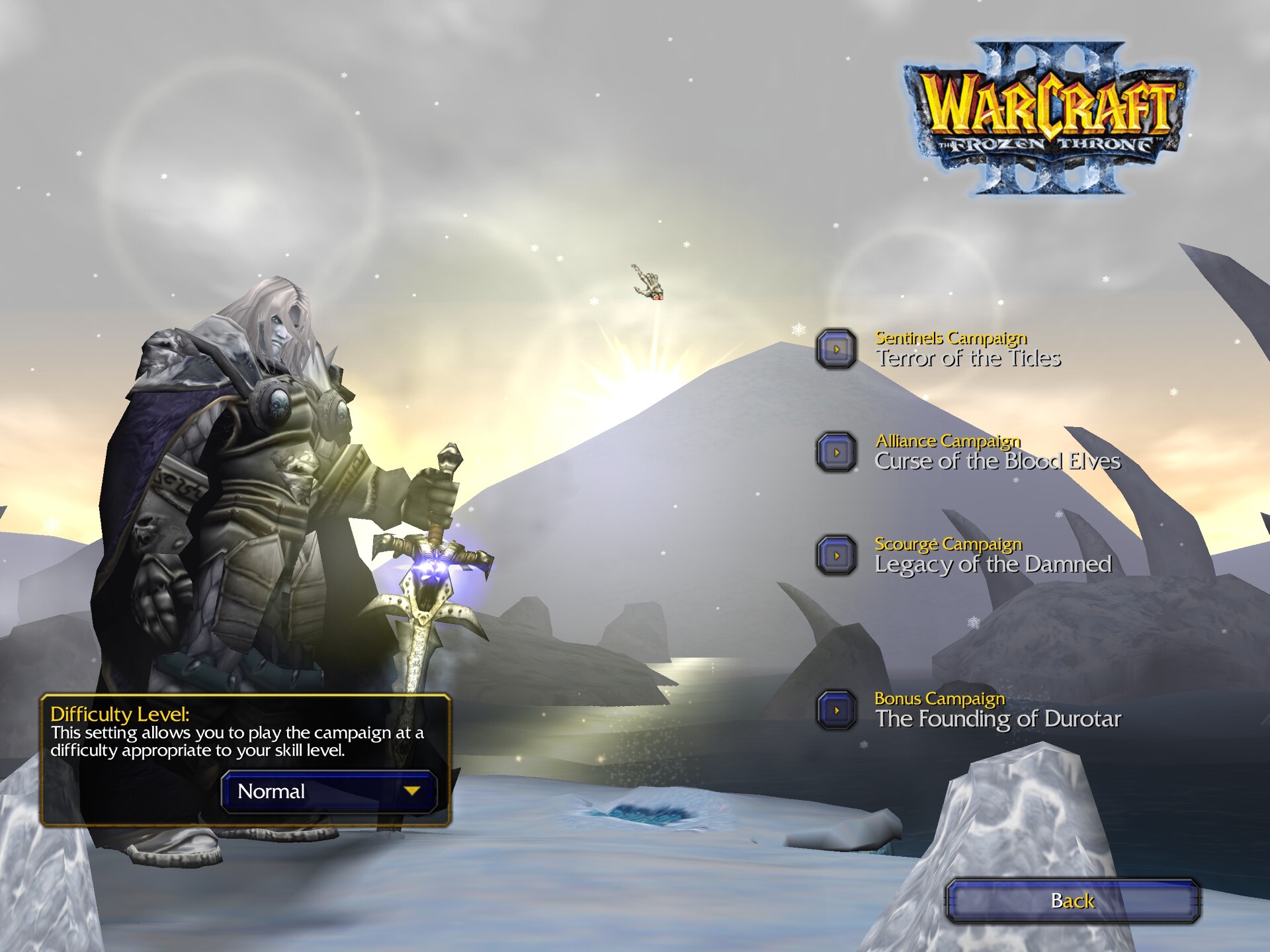
Curse of the Blood Elves was the shortest campaign in the game, except for the orc prologue campaign. The Scourge campaign, Legacy of the Damned, is, in contrast, the longest campaign in the game. Officially it has eight chapters, but one chapter is actually three missions in a trenchcoat, for a total of whopping ten missions. Because of the sheer length of this campaign, I intend to cover it in three posts instead of the usual two.
The reason it’s so long is because it tells two largely independent stories, one setting up the undead faction in World of Warcraft1, and the other wrapping up the Frozen Throne storyline. Storytelling-wise it would probably make sense to split this campaign in two, but then some players wouldn’t be pleased to play two campaigns for the same faction in a row.
We leave Outland behind and return to Lordaeron, now ruled by…
King Arthas

The explosive ending to Reign of Chaos didn’t give closure to the Scourge storyline, leaving its fate uncertain. We saw the Scourge march to Mount Hyjal under the Burning Legion’s command, but Arthas, who was inexplicably in Kalimdor, helped foil the invasion. But what happened to the Scourge after that?
We’re back in Lordaeron. Three differently colored dreadlords — Varimathras the red, Detheroc the green2, and Balnazzar the purple — are overseeing the Scourge in Archimonde’s absence.
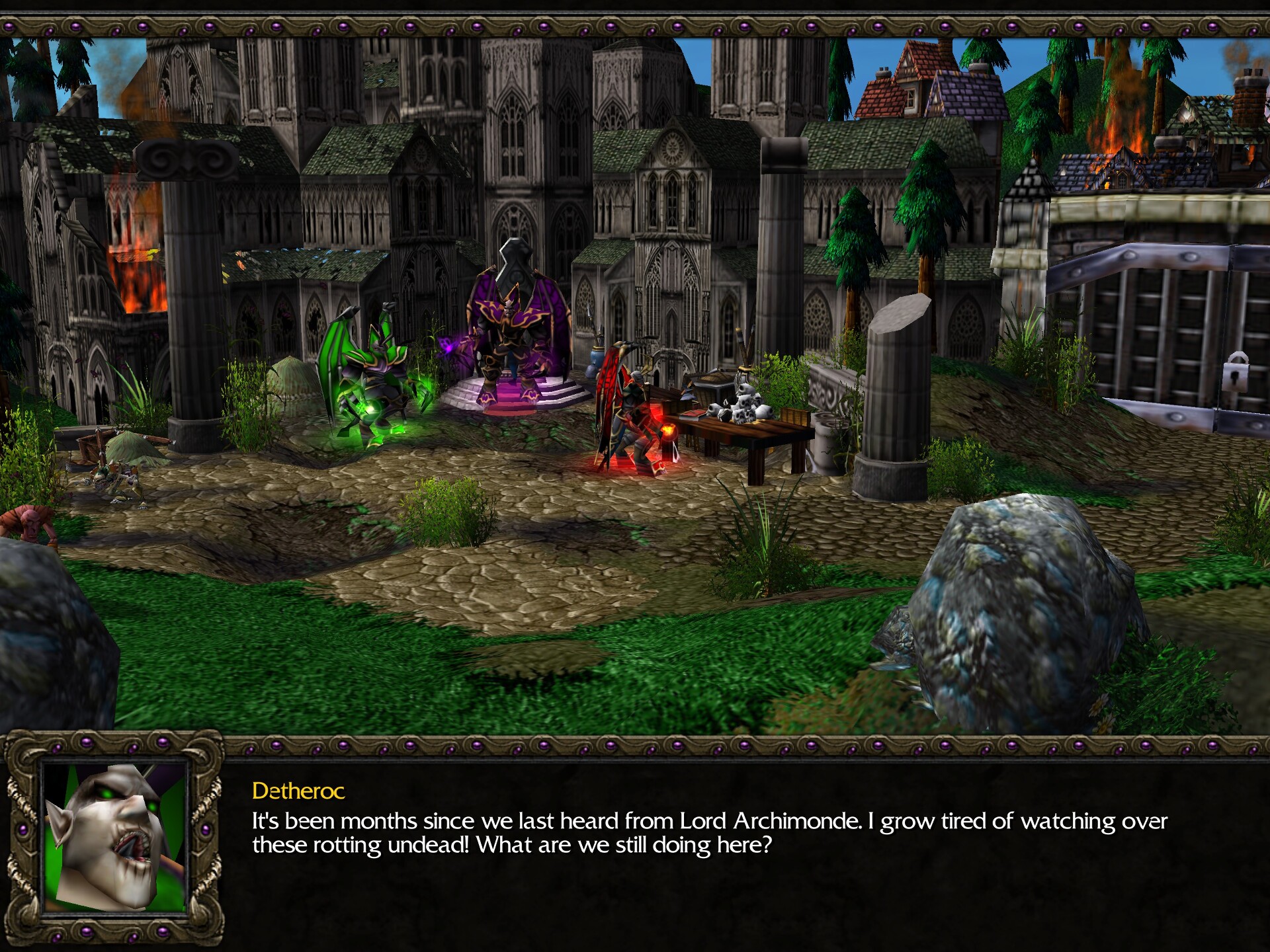
They haven’t heard from Archimonde or received any orders in months, and they’re getting worried. Unknown to them, they’re being watched by Kel’Thuzad and Sylvanas, and the latter asks a very good question.
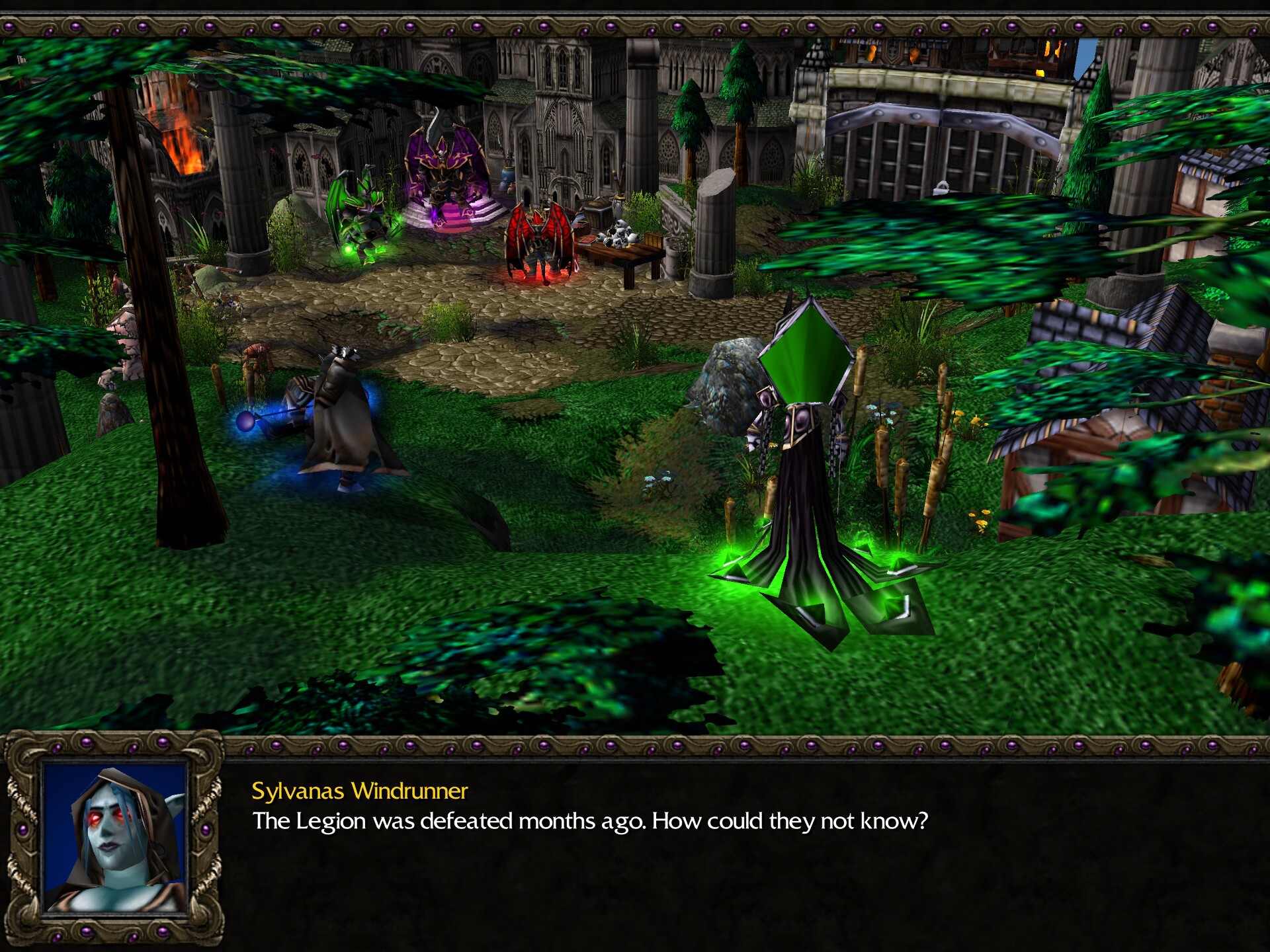
How could they not know, indeed? Tichondrius in the previous undead campaign exchanged news with the other dreadlords. Presumably any surviving remains of Archimonde’s army could have brought the news of Archimonde’s demise by the same means. Actually, what happened to that army, anyway? Did all the demons just poof out of Azeroth when Archimonde was torn apart by wisps?
Mind you, that’s the least of the questions I have. What intrigues me more is Sylvanas’s model change. Clearly, something happened to her offscreen between the two undead campaigns, and it goes entirely unaddressed in-game.
In the vanilla undead campaign, Arthas raised Sylvanas as a banshee, an incorporeal ghost. Here, however, she’s a dark ranger, a corporeal undead elf. It’s not explained how or why she got a body again, whether it’s her old body or someone else’s, or even if it’s a retcon and she was never an incorporeal banshee to begin with. The dark ranger is actually a playable neutral hero in multiplayer, so perhaps the campaign writers wanted to showcase it in this way.
Suddenly, Arthas bursts in by breaking the gate!
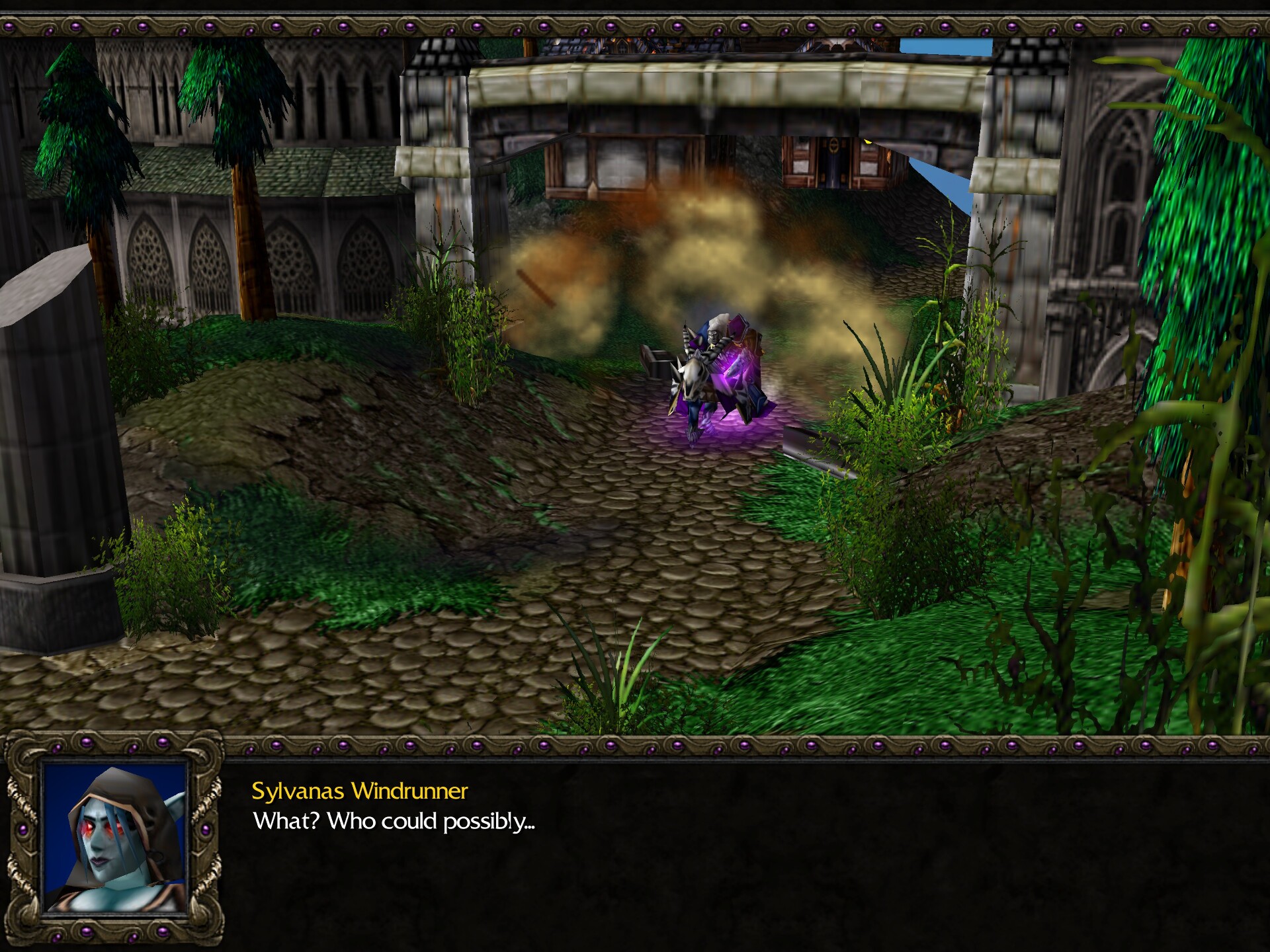
The dialogue subtitles address him as “King Arthas” now, and indeed, that’s how he demands to be addressed now. He tells the dreadlords that their Legion masters have been defeated. Like good Saturday morning cartoon villains, the dreadlords say “This isn’t over, human!” and teleport away, even though, from their perspective, they have no reason to believe Arthas and every reason to tear him apart in a three-on-one fight.
With the dreadlords gone for now, Arthas addresses Kel’Thuzad and Sylvanas. To solidify his rule as the new, undead king of Lordaeron, he wants the scour the kingdom of the last remnants of humanity, but there’s a problem: the humans have begun abandoning their villages.
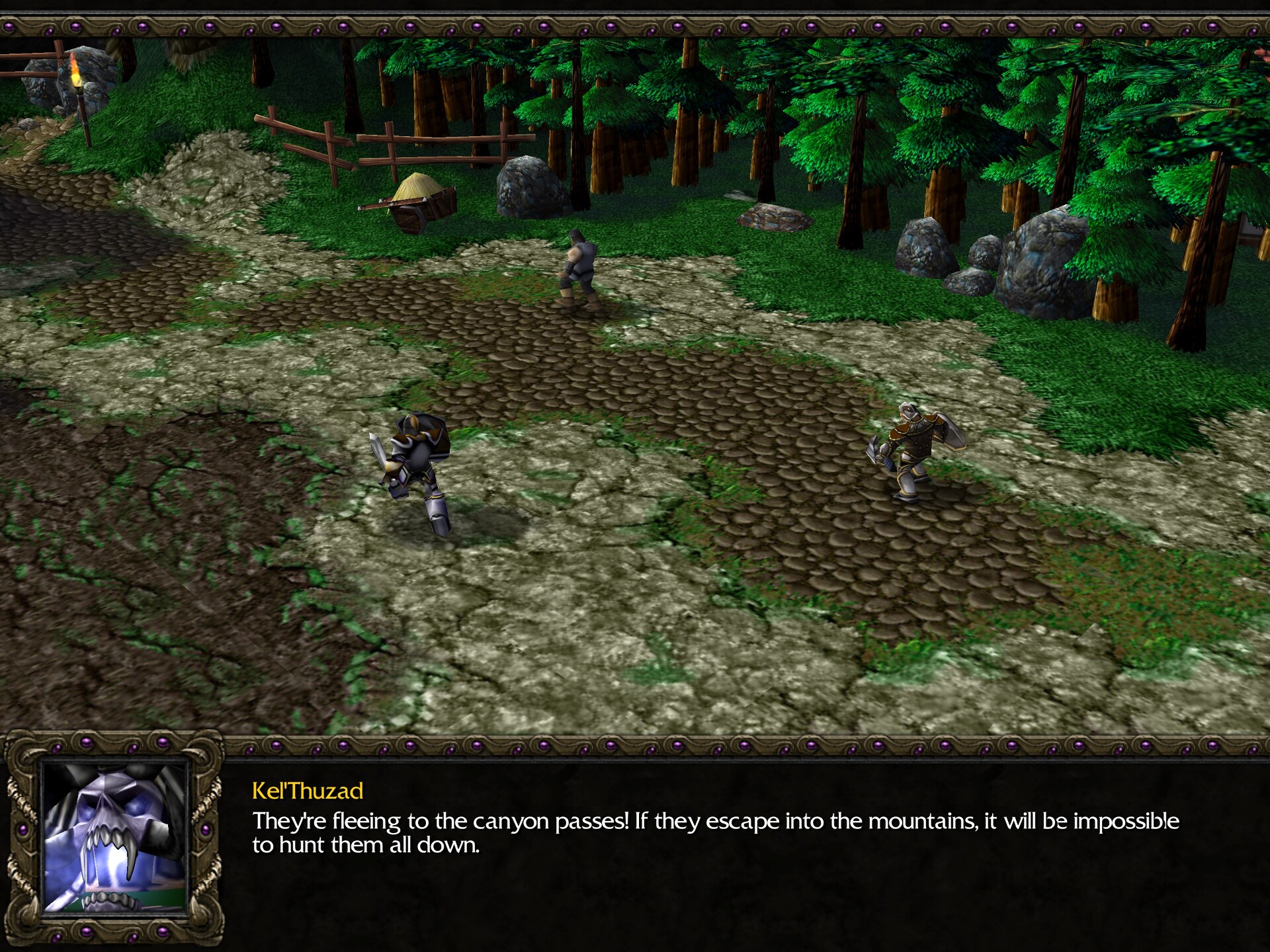
And so, it falls to Arthas, Kel’Thuzad and Sylvanas to intercept the escaping human refugees and slaughter them before they get to safety.
Thus begins the mission — a very unique one.
We’re controlling three sides: Arthas, Kel’Thuzad, and Sylvanas. Each of them guards a corner of the map where human refugees are flocking, and if we let twenty or more villagers escape, we fail the mission. We’re given practically unlimited resources, but each side can only build ghouls and one more unit. For Arthas it’s abominations, for Kel’Thuzad, necromancers, and for Sylvanas, banshees.
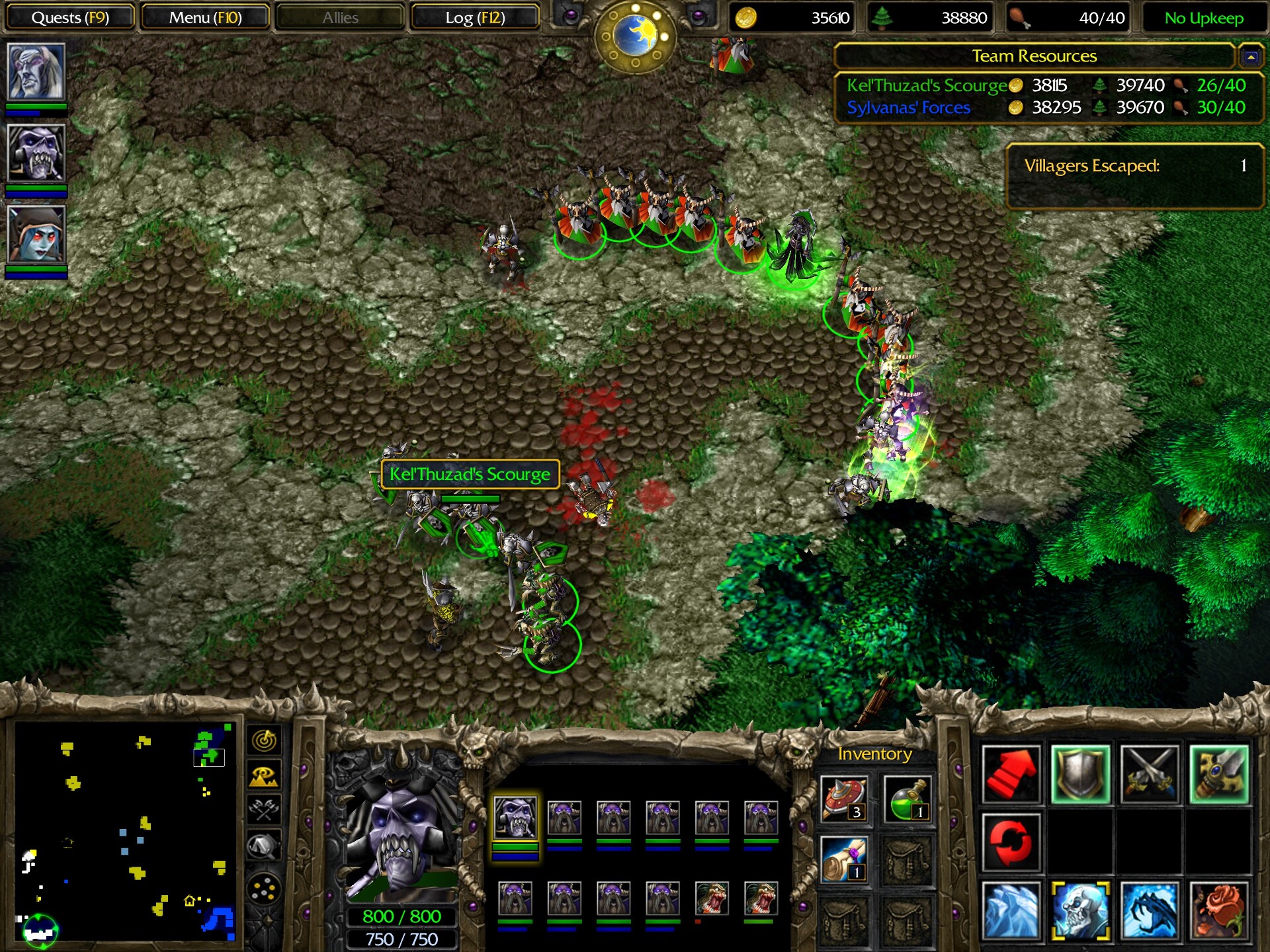
To eliminate the opposition, we must destroy nine refugee camps across the map. But on top of everything else, there’s an additional complication.
Every time you attack a refugee camp, a paladin and two knights teleport in. The paladins respawn at altars at the base in the center of the map, which also blocks the way between Arthas, Kel’Thuzad, and Sylvanas’s portions.
Thankfully, like many others, this mission becomes substantially easier if you know the trick.
Each of the three heroes starts with three goblin land mines. Immediately after gaining control, I took a lone Arthas on a suicide run to the central base. As he stood between the three altars, I placed all three land mines there. The resulting explosion took out all three altars at once — at the cost of getting Arthas killed, but then I revived him at my own altar and took him and his abominations on a rampage through his section of the map. Once the paladin assigned to that corner got killed, he stayed dead. Having eliminated all three refugee camps, I then assaulted the central base and killed the remaining two paladins for good.3

Meanwhile, Kel’Thuzad and Sylvanas defended their passes. Kel’Thuzad is not ideal for offense, since he has the squishiest unit, but the necromancers and their skeletons are very good at holding the line, so he stayed in defense for this mission. Sylvanas, meanwhile, has been growing her forces. Her banshees possessed big, juicy units such as knights and militia captains, and she herself leveled twice, from level 2 to level 4.
Arthas and Kel’Thuzad, meanwhile, both started at level 10, but this is about to change. As soon as we raze the sixth refugee camp, a cutscene plays. Arthas is struck by crippling pain — and we see the Lich King for the first time!
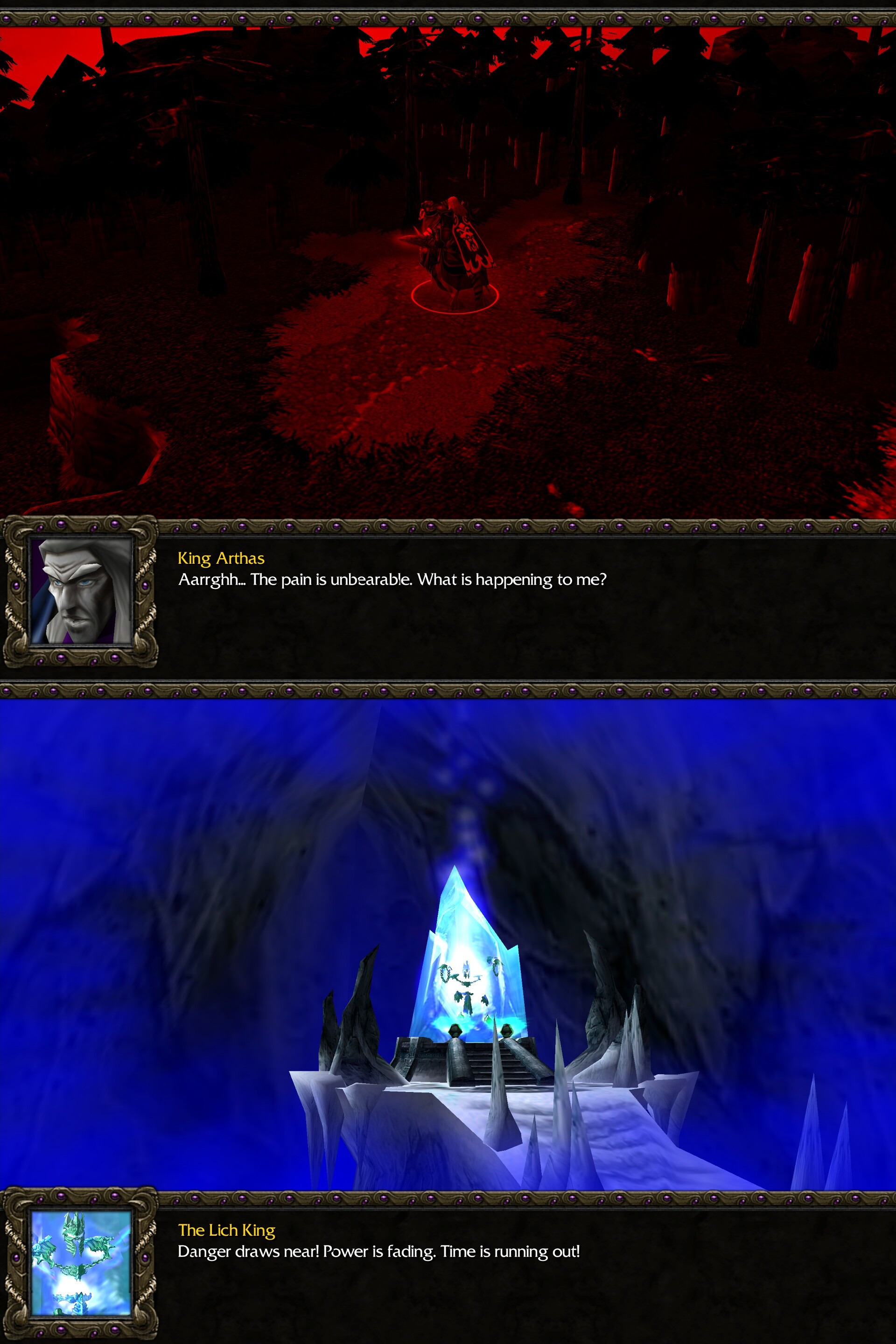
Unlike regular liches, who are obviously reanimated orc skeletons4, the Lich King is apparently a suit of armor encased in a block of ice, with no bones in sight.
Kel’Thuzad arrives and asks if Arthas needs assistance. Arthas says that the pain has passed, but his powers have diminished. Once we regain control of him, he has been knocked down to level 9.
After Arthas destroys the three refugee camp on Sylvanas’s side, Sylvanas can join him with her forces, now consisting mostly of possessed units. Together they demolish the remaining three camps on Kel’Thuzad’s side.
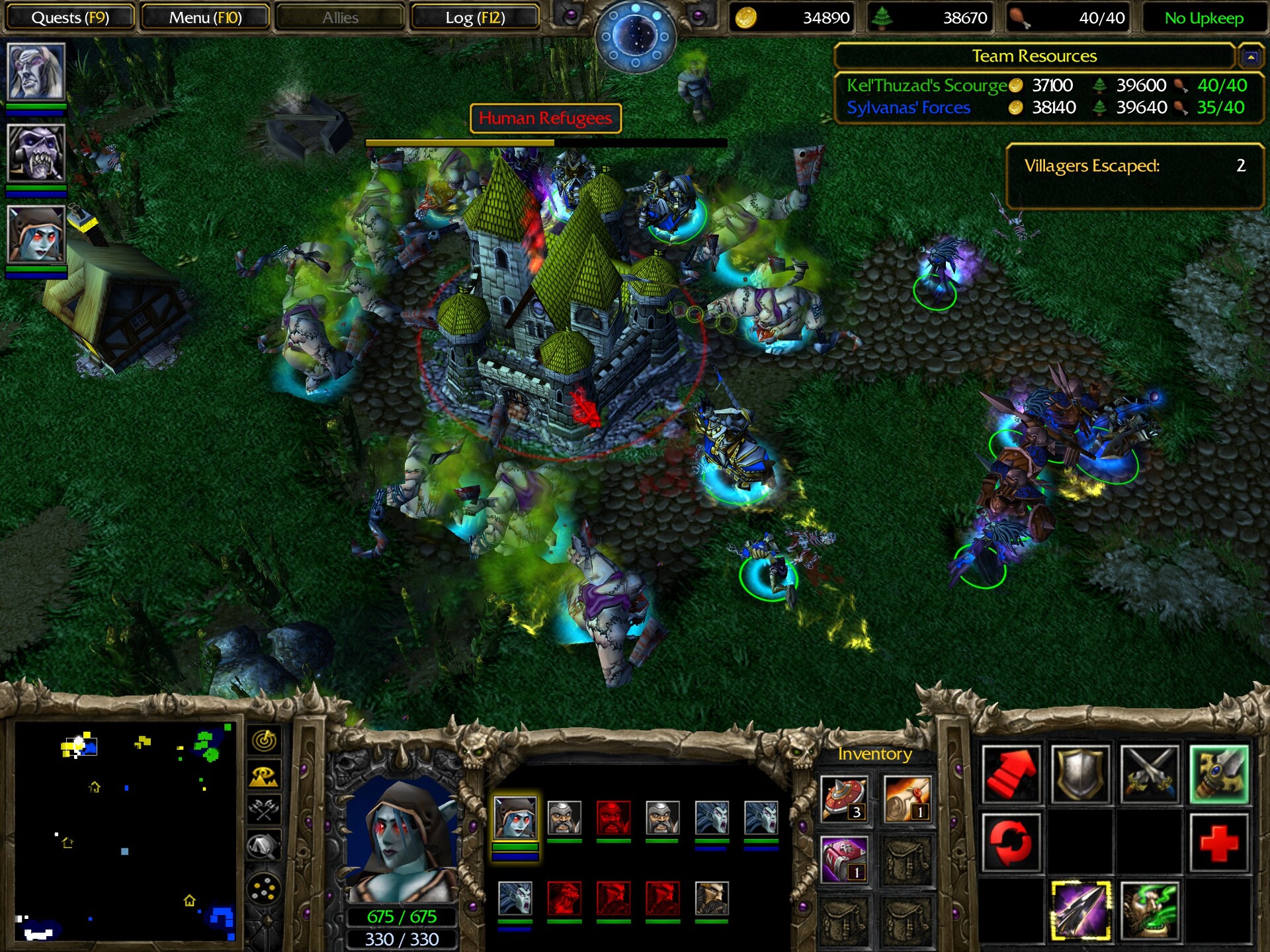
Humanity has been eradicated in Lordaeron, but Arthas has another episode of crippling pain.

The king will not be staying in his kingdom for long, after all. He asks Kel’Thuzad to take him back to the capital, as he has a long journey ahead of him.
A Kingdom Divided
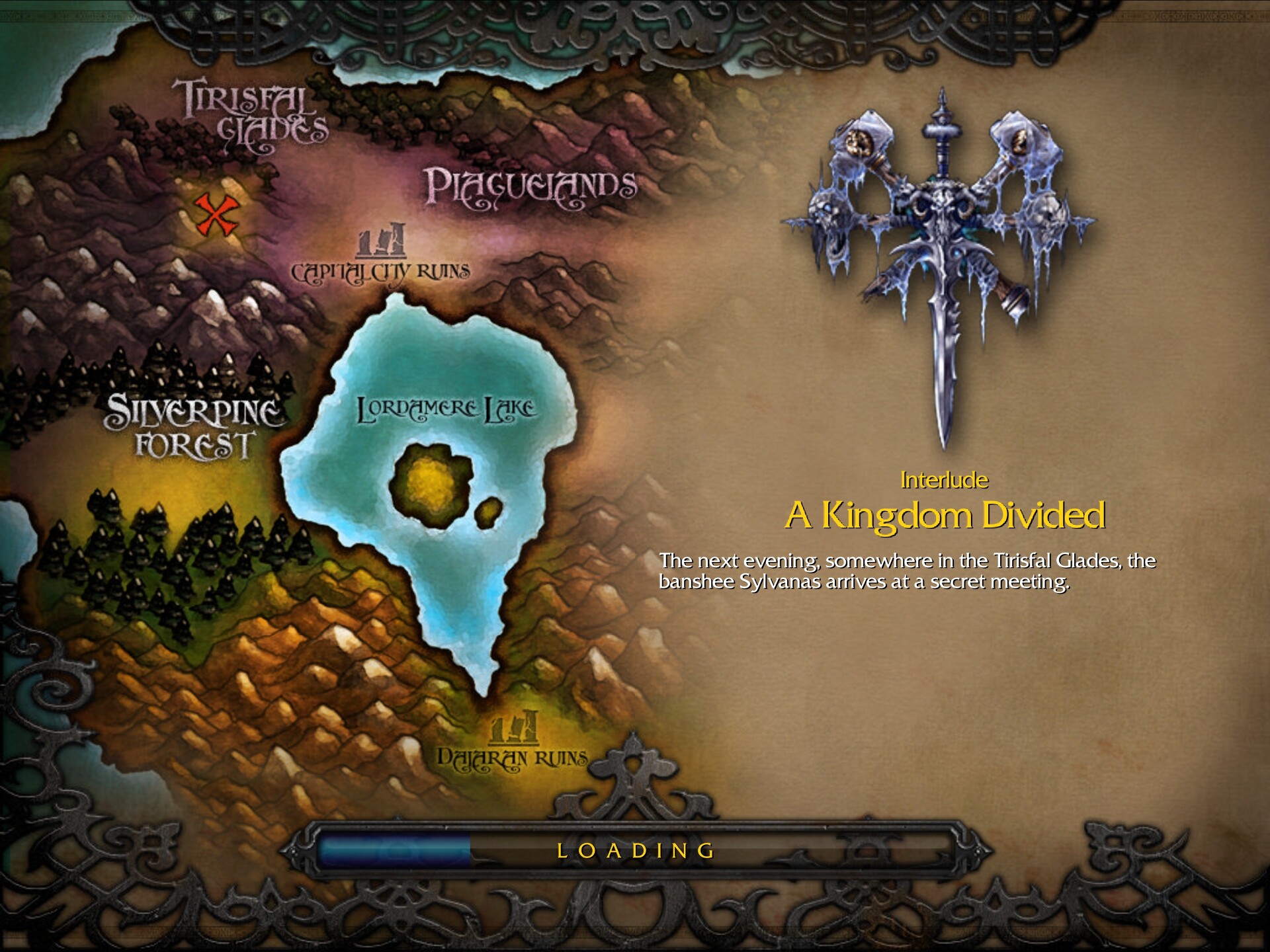
The next evening, Sylvanas arrives at the dreadlords’ hideout, and they’re pleased that she came.

She believes the dreadlords know why, and indeed they do. They’ve discovered that the Lich King is losing his power, and with it, his ability to command undead. Arthas’s powers will thus also fade over time, which is convenient for the dreadlords’ plans to overthrow him. While Kel’Thuzad is too loyal to betray his master, they believe Sylvanas, whose people Arthas murdered and whom he raised into undeath by force, will be more easily turned against him.
However, Sylvanas rejects the proposed alliance. She will execute her vengeance in her own way. With that, she leaves. While Balnazzar doesn’t trust her, believing her heart is still elven, Varimathras and Detheroc think she might still prove useful to the dreadlords’ cause.
The Flight from Lordaeron
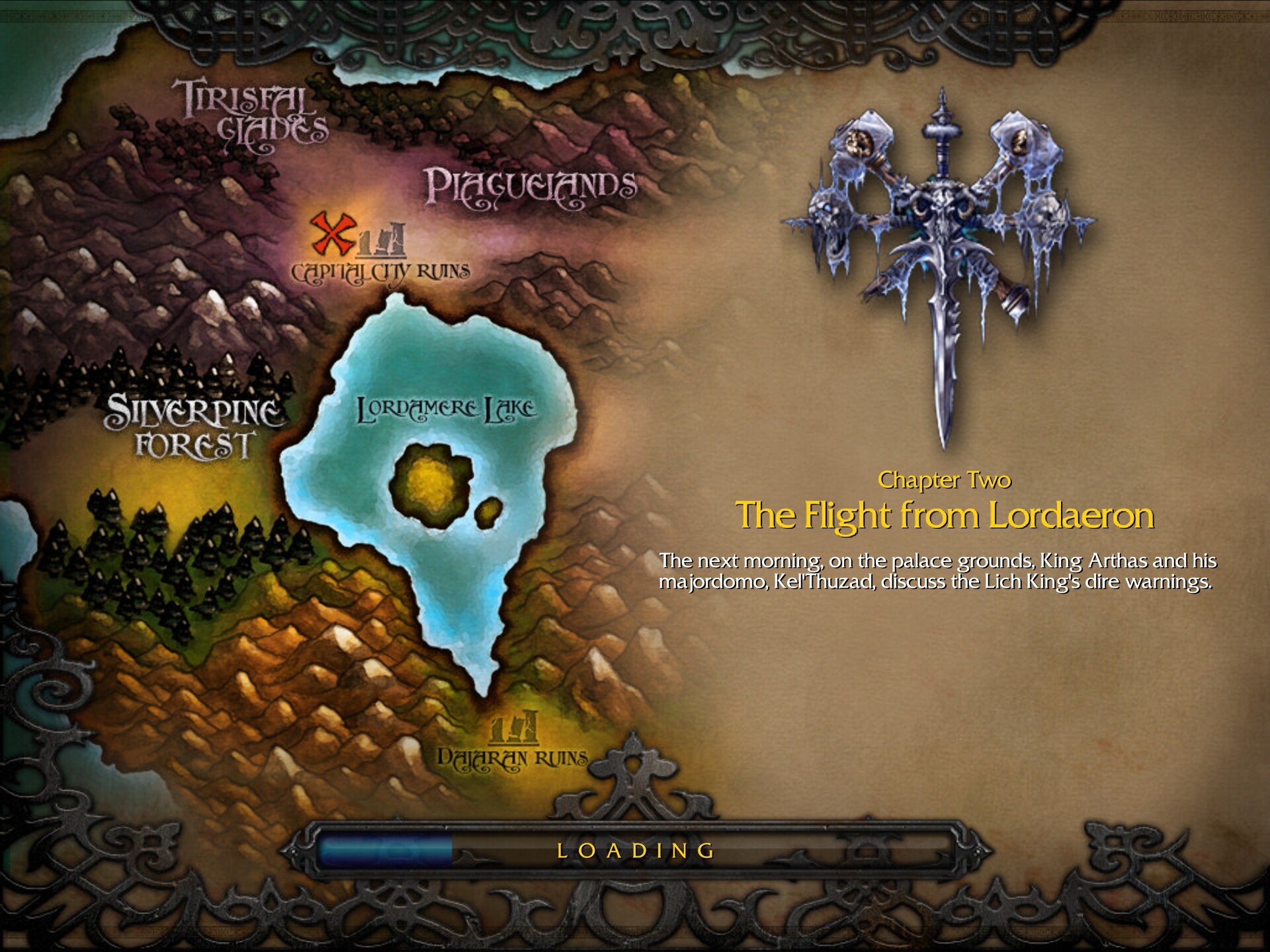
Arthas, accompanied by Kel’Thuzad, walks into Capital City, but… it’s a trap!
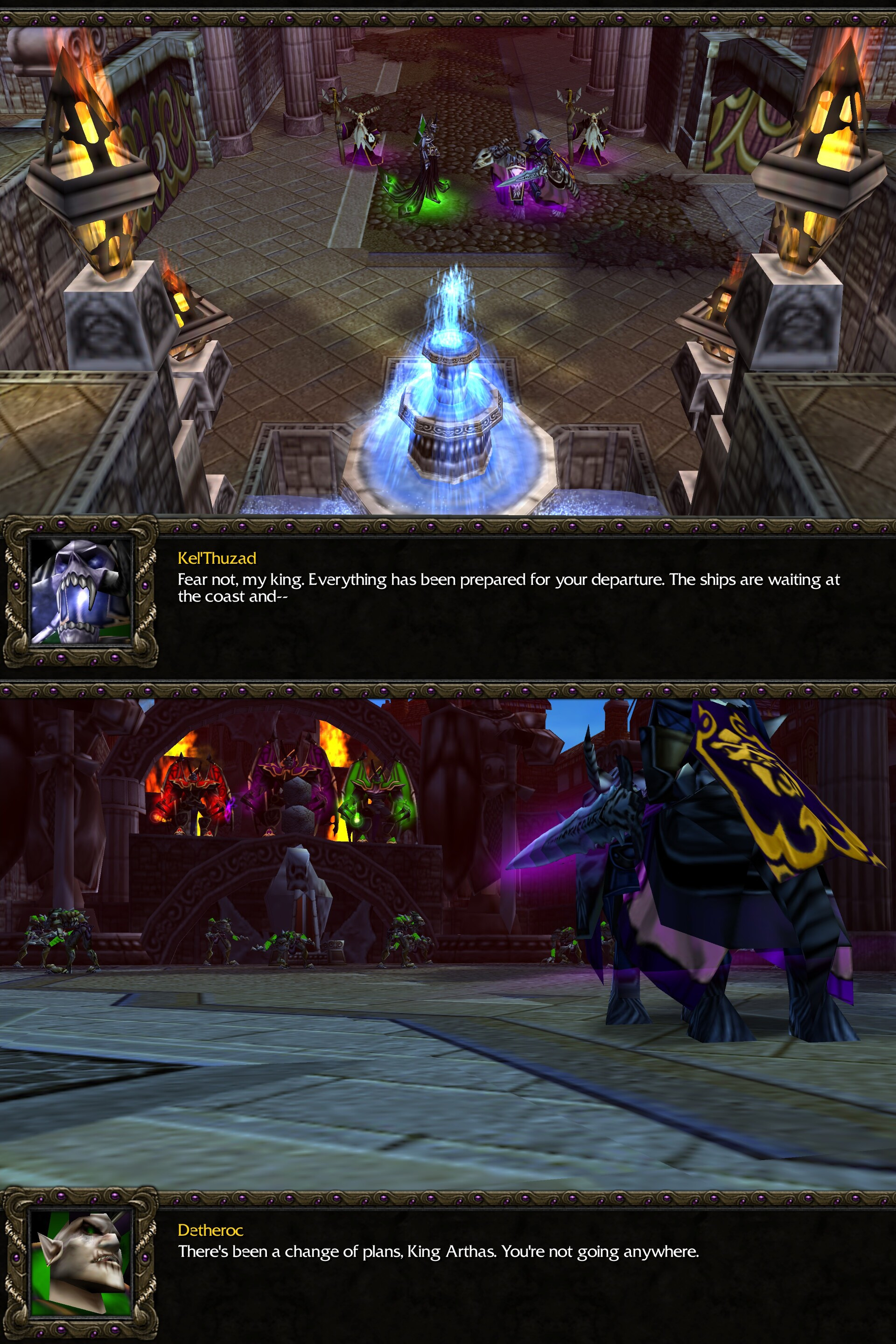
The door behind Arthas closes, separating him from Kel’Thuzad, and ghouls surround him. And… here’s where I have complaints about the design of the cutscene, the same ones as voiced by the author of the Campaign Masterpiece or Overrated? video.
Usually, Warcraft 3 cutscenes make sense in terms of mission gameplay, and the integration between gameplay and story is one of this game’s strengths. Here, however, what’s happening in the cutscene makes no sense in terms of both the story and the gameplay.
As Arthas is surrounded by ghouls, the dreadlords just watch from their high ground instead of joining the action. Once the cutscene ends, they’re nowhere to be found.
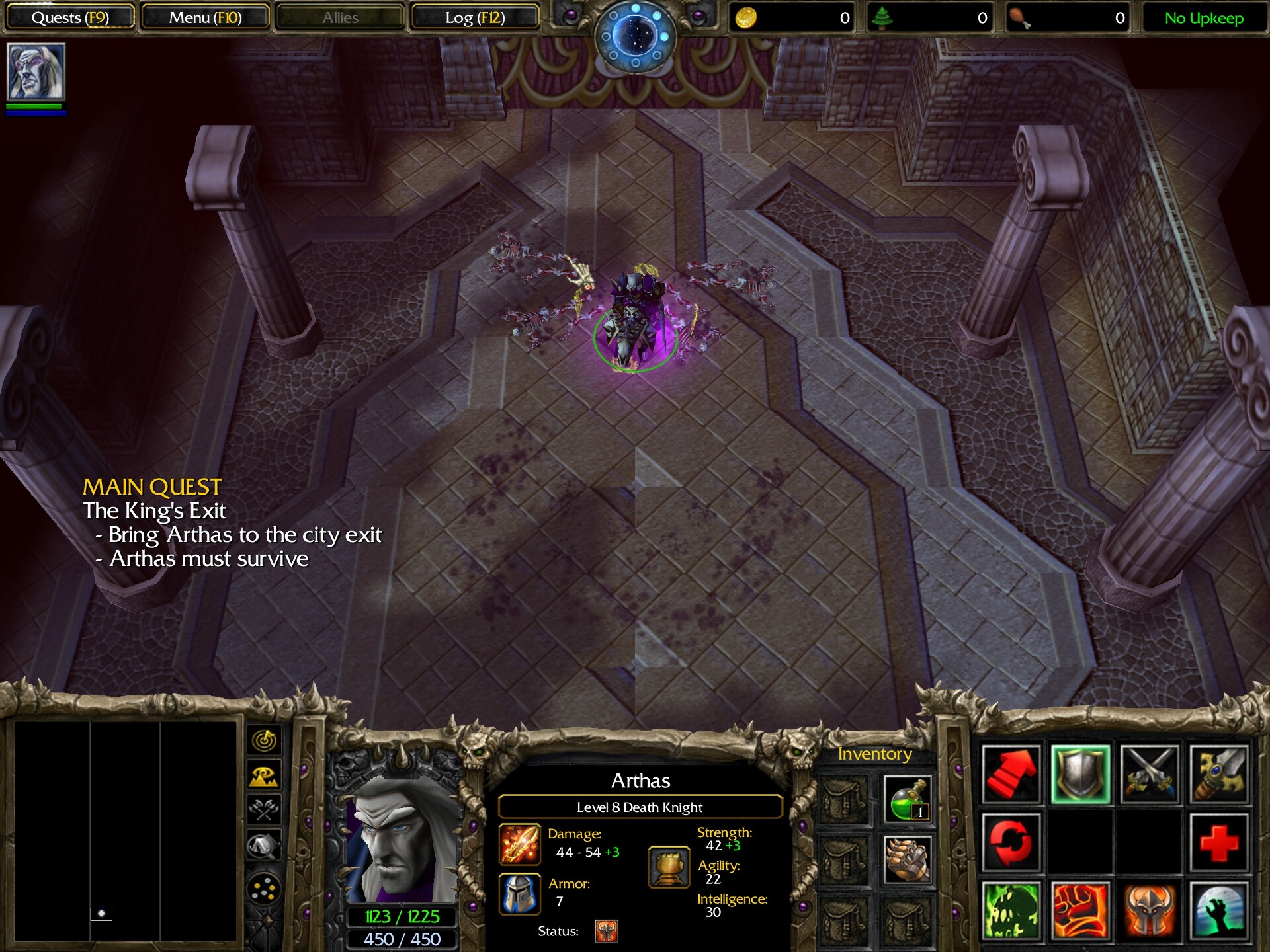
Furthermore, that gate to Arthas’s north — the first one he’s going to break through in the actual mission — is the one Kel’Thuzad was behind just moments ago, yet once we break it, he’s nowhere to be found. How did he escape the city?
This mission is not bad, just kind of… bland. It consists of pushing farther and farther north through a very tall and narrow rectangle of a map, gathering forces while killing hostile undead loyal to the dreadlords. Like unseasoned food, it’s nourishing but lacks flavor, because it’s a dungeon crawl where the designers forgot to put good loot and exciting events in.

Adding to the annoyance, most of the enemy units are undead, so Death Coil doesn’t work on them. It can only be used to heal allied undead units.
We fight through undead, golems and eventually demons, making an army composed of necromancers, ghouls, crypt fiends, meat wagons, and abominations. One detail I appreciate is that periodically, hostile zombies and ghouls spawn in our rear. While they’re a weak nuisance, they provide enough of a distraction that you can’t afford to sit idle for long, just in case you had ideas of going away from keyboard while your units replenish HP and mana.
Some of the enemy packs are led by dreadlords, but confusingly, they aren’t our main three dreadlords, they’re just… some dreadlords. The one at the final gate leads a pack consisting of two regular abominations and an awesome boss abomination.
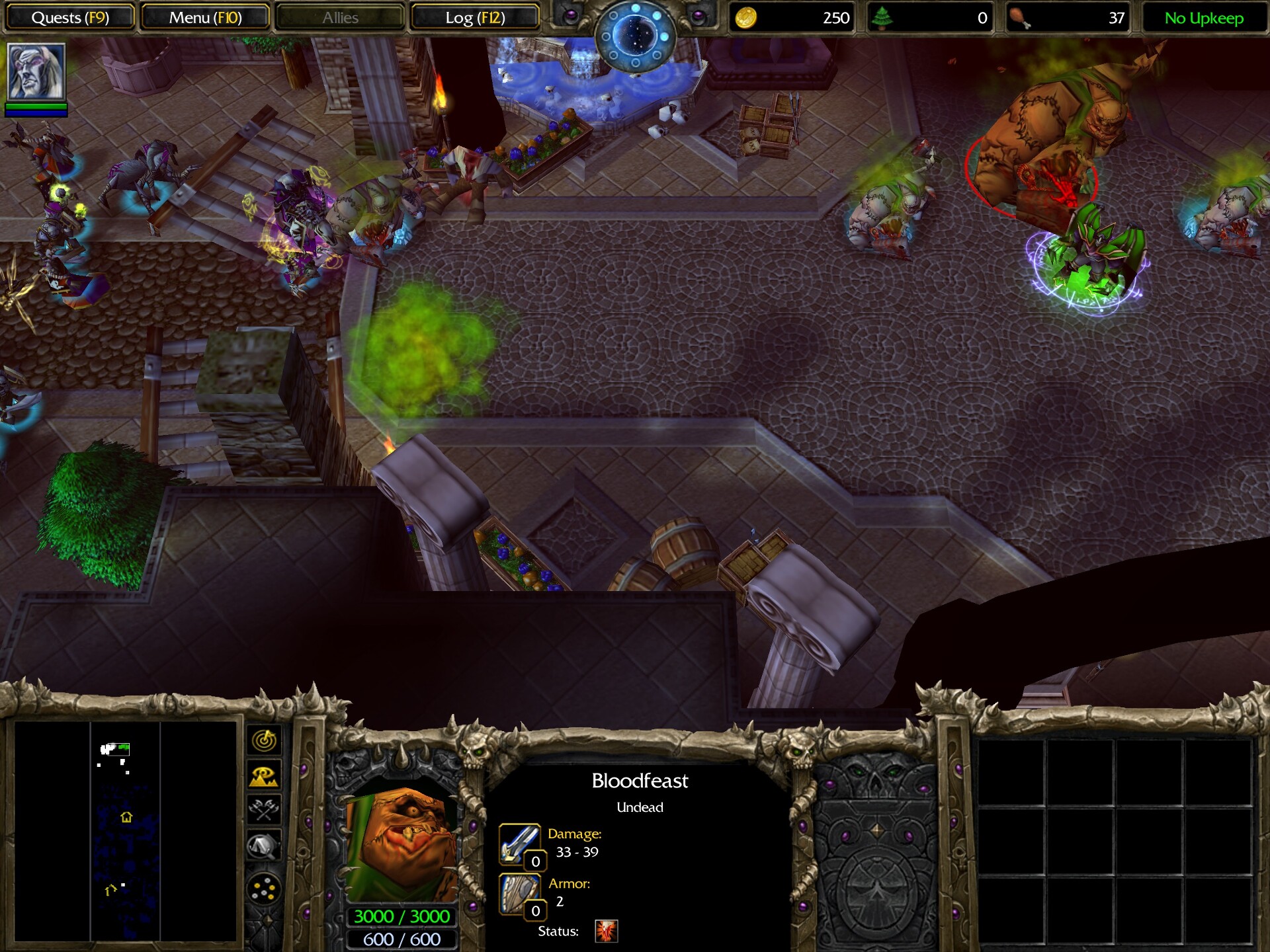
Arthas has fought his way out of the city… but he finds the way blocked by four abominations. Suddenly, however, banshees appear and possess two of the abominations, making them fight their comrades.
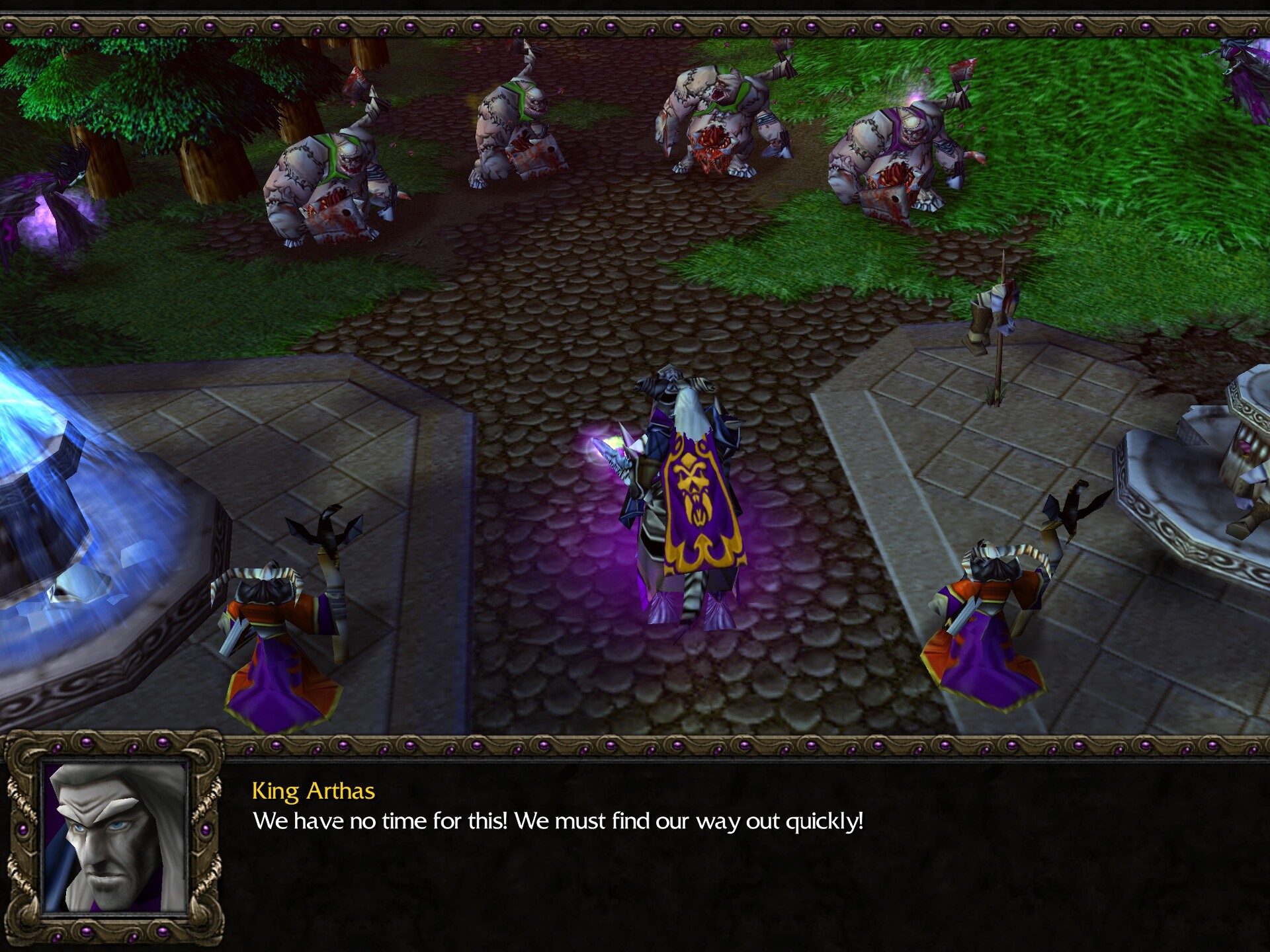
One of the banshees explains that they were sent by Sylvanas to escort Arthas across the river. After that, they’ll take refuge in the wilderness. An unsuspecting Arthas follows them.
Sylvanas’ Farewell
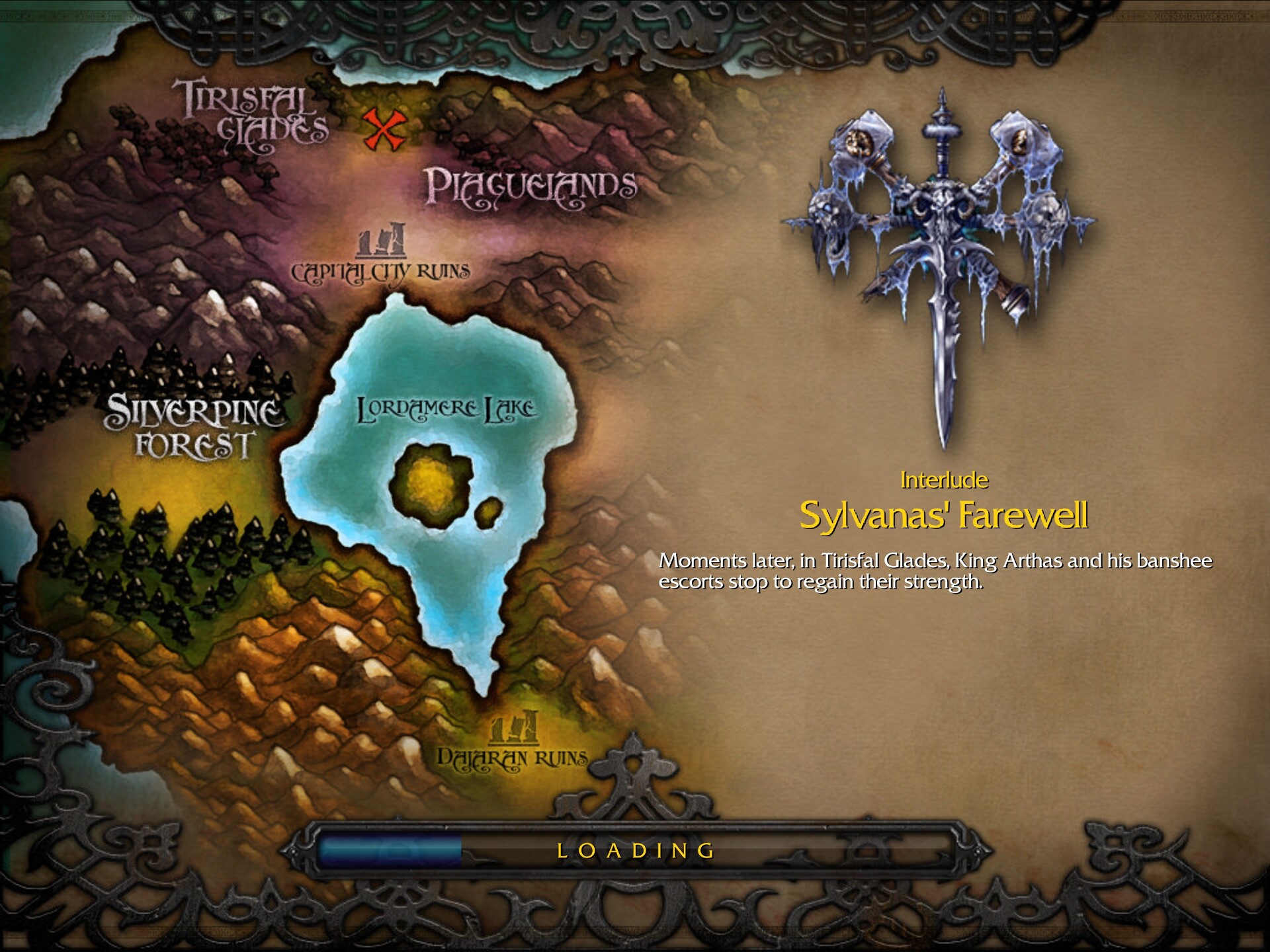
The banshees are leading Arthas through the wilderness. Suddenly, however, he has another fit of pain.
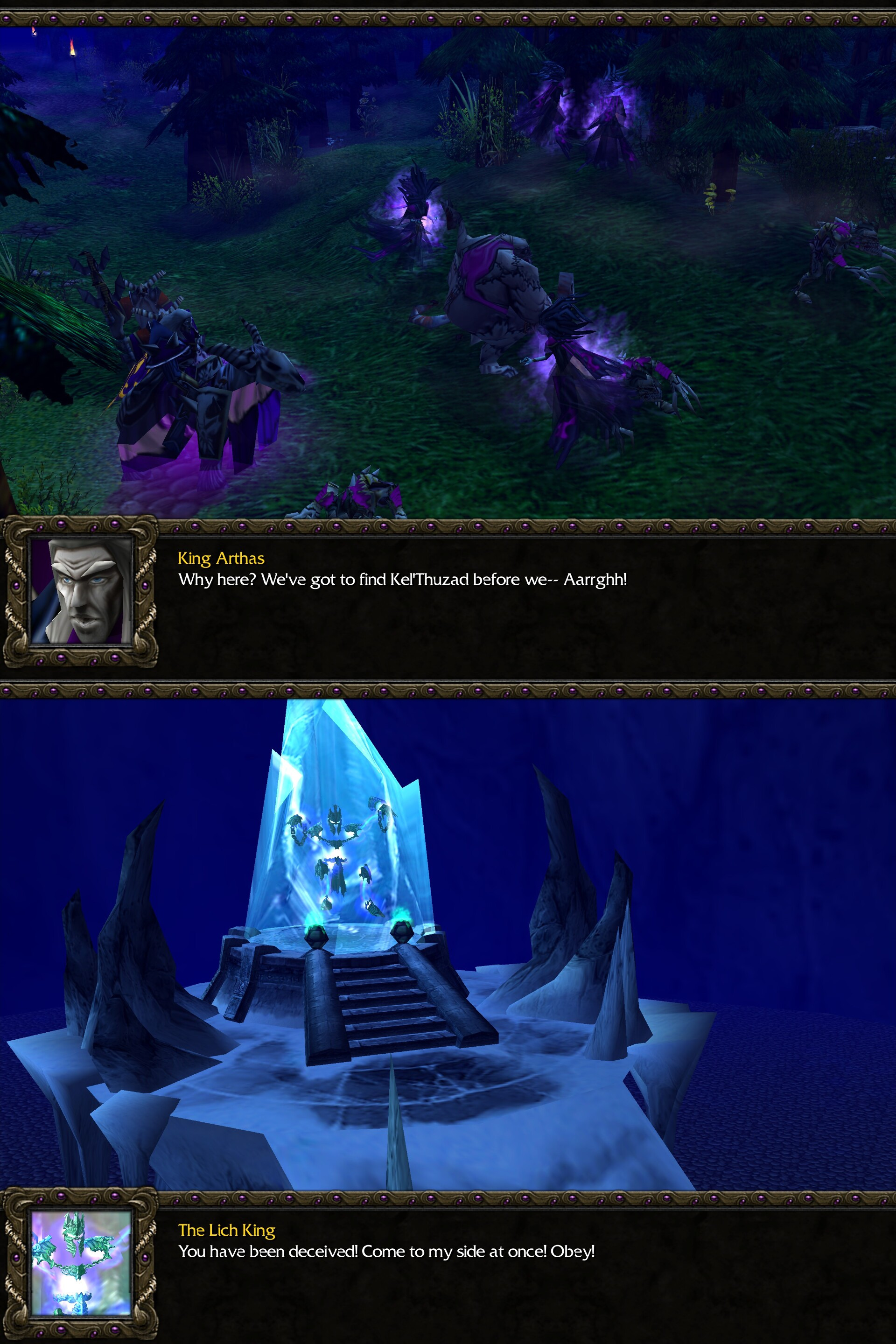
Once his mind clears, he finds the banshees attacking his own forces. Suddenly, he is struck by a black arrow and immobilized, and Sylvanas appears.
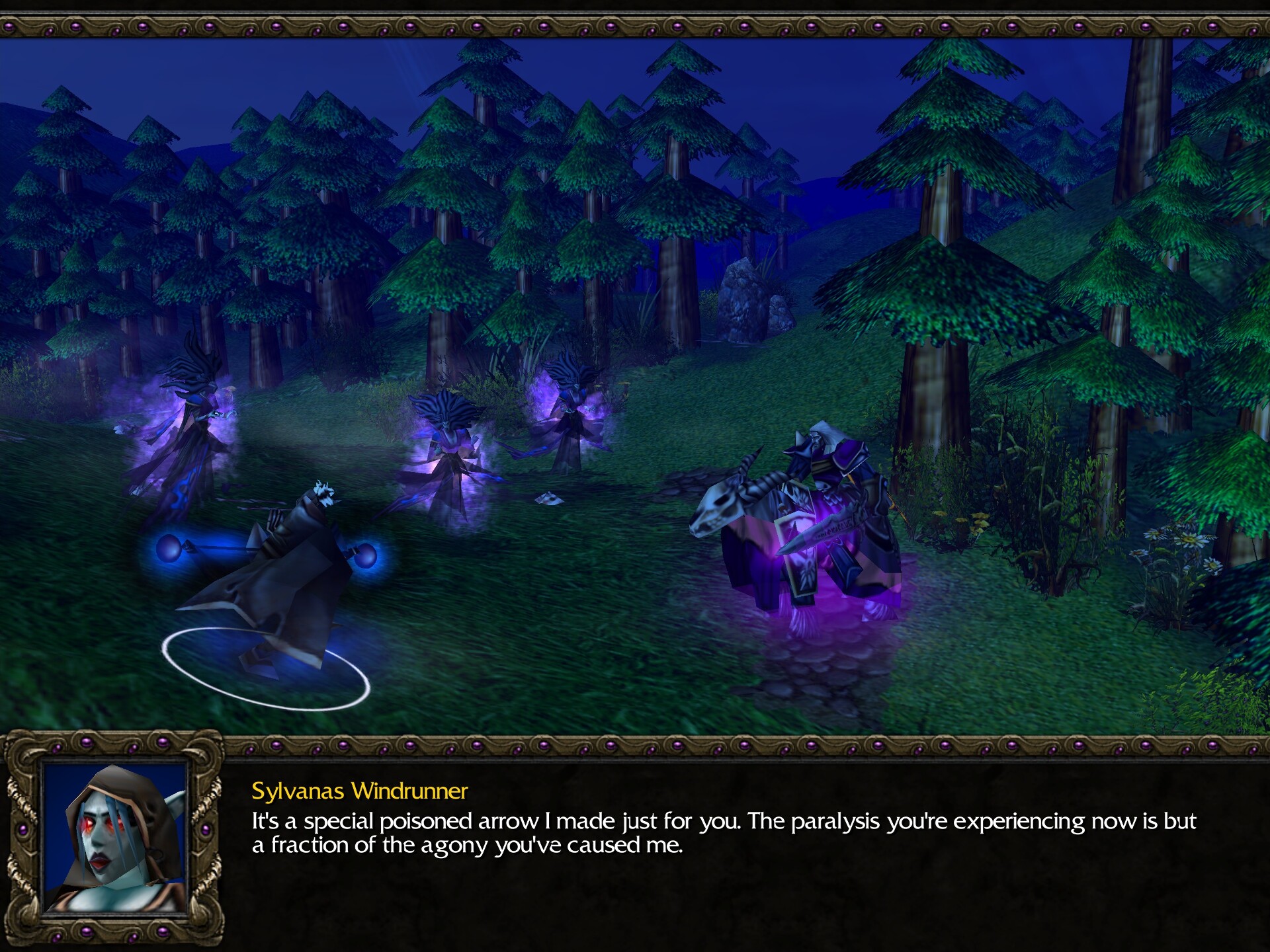
Arthas tells Sylvanas to finish him, but she refuses. (Oh, she should have!) She’d rather deny Arthas a quick death, like he denied her, so he’s going to suffer as Sylvanas herself did.
At this point, however, Kel’Thuzad arrives and chases Sylvanas away.
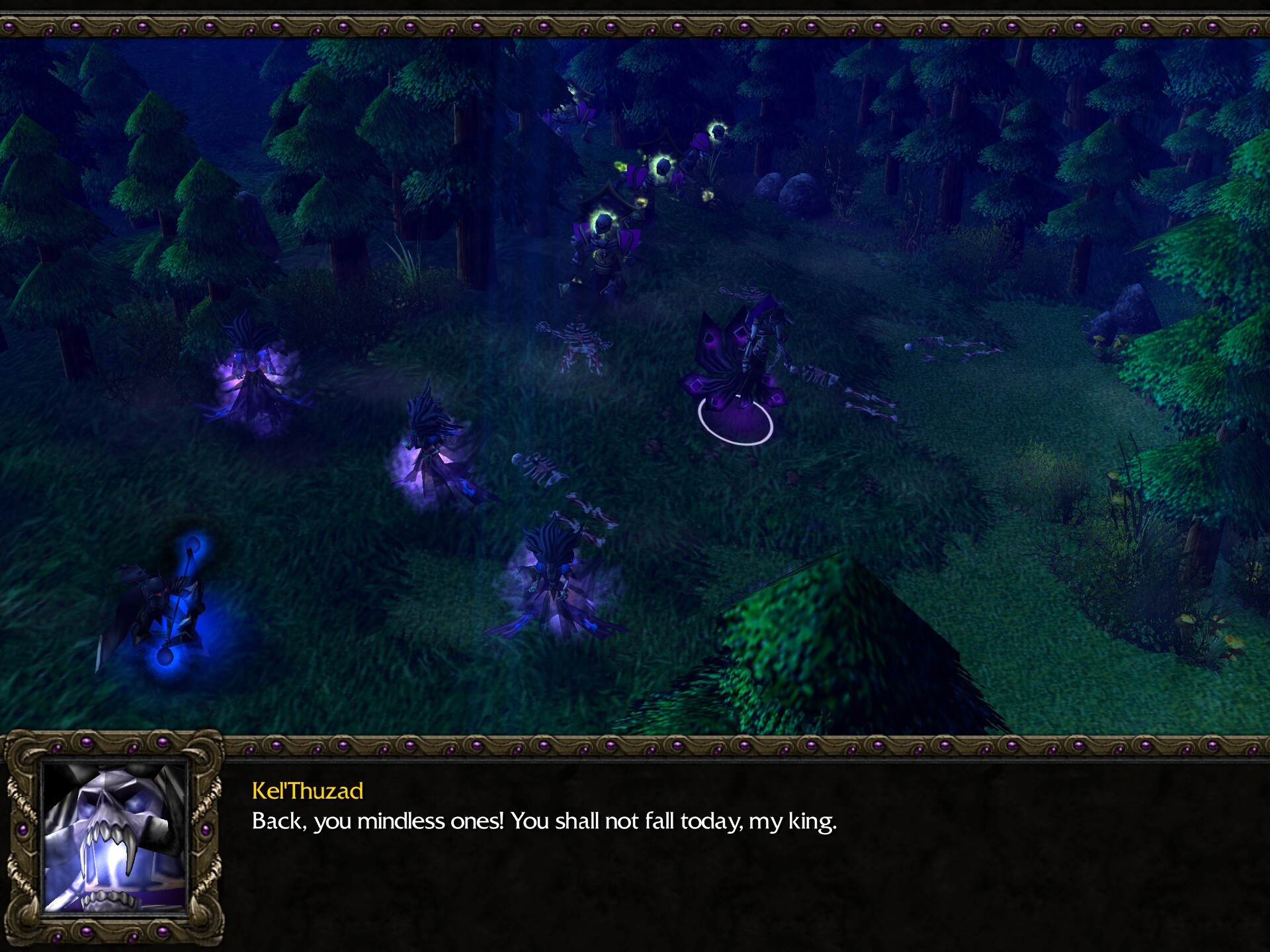
And… that’s it. Sylvanas runs away, and Arthas is well in good in the immediate next scene, where he’s preparing to set sail for Northrend.

To this day, I find this interlude bizarre.
Remember when Frodo was struck by a Morgul blade at Weathertop Hill and was fully healed five minutes later? I don’t either, because it would make for a bad story. His wound became a source of pain and anguish that didn’t go away even after Sauron was defeated, forcing him to leave Middle-earth before he could spend the rest of his days in peace.
The poisoned arrow that Sylvanas struck Arthas with is immediately dealt with and completely forgotten after this cutscene. It simply never comes up, either here or later in the campaign. I wonder what the point of it was, and whether it’s a remnant of an earlier draft of the story. This entire interlude is superfluous. It serves to establish Sylvanas’s defiance of Arthas, which we already know about. The final scene with the ships showcases Kel’Thuzad’s loyalty to Arthas, with the two bonding in a twisted sort of friendship, but it could have just as easily been moved to the end of the previous mission, and the interlude cut entirely.
At this point, the campaign branches into two storylines: Arthas’s and Sylvanas’s. It will be a while before we return to Arthas and his voyage to Northrend. For now, we’ll be following…
The Dark Lady
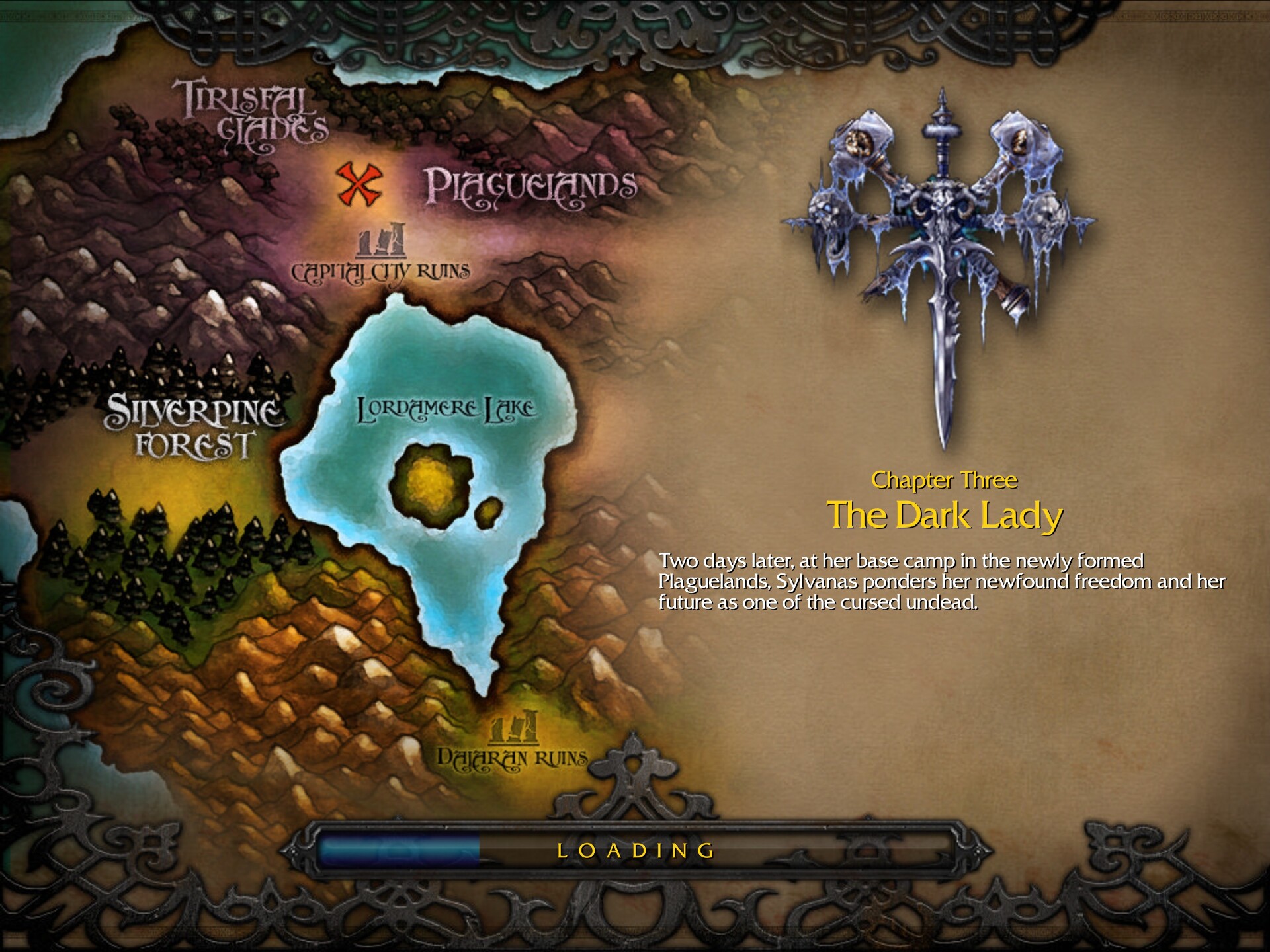
At her base, Sylvanas is brooding. “You seem troubled, mistress,” remarks a banshee.

To Sylvanas, they’re still undead, still monstrosities, and there’s no joy to be had while they’re slaves to this torment.
Suddenly, a portal opens, and Varimathras steps out.

Sylvanas refuses to join the dreadlords. Her only interest was in seeing Arthas dead, and she has no time for petty politics or power mongering. More importantly, she lived as a slave long enough and isn’t going to shackle herself to new masters.
Varimathras leaves, promising the dreadlords’ reply will come soon. Thus begins a really fun twist on base-sieging missions.
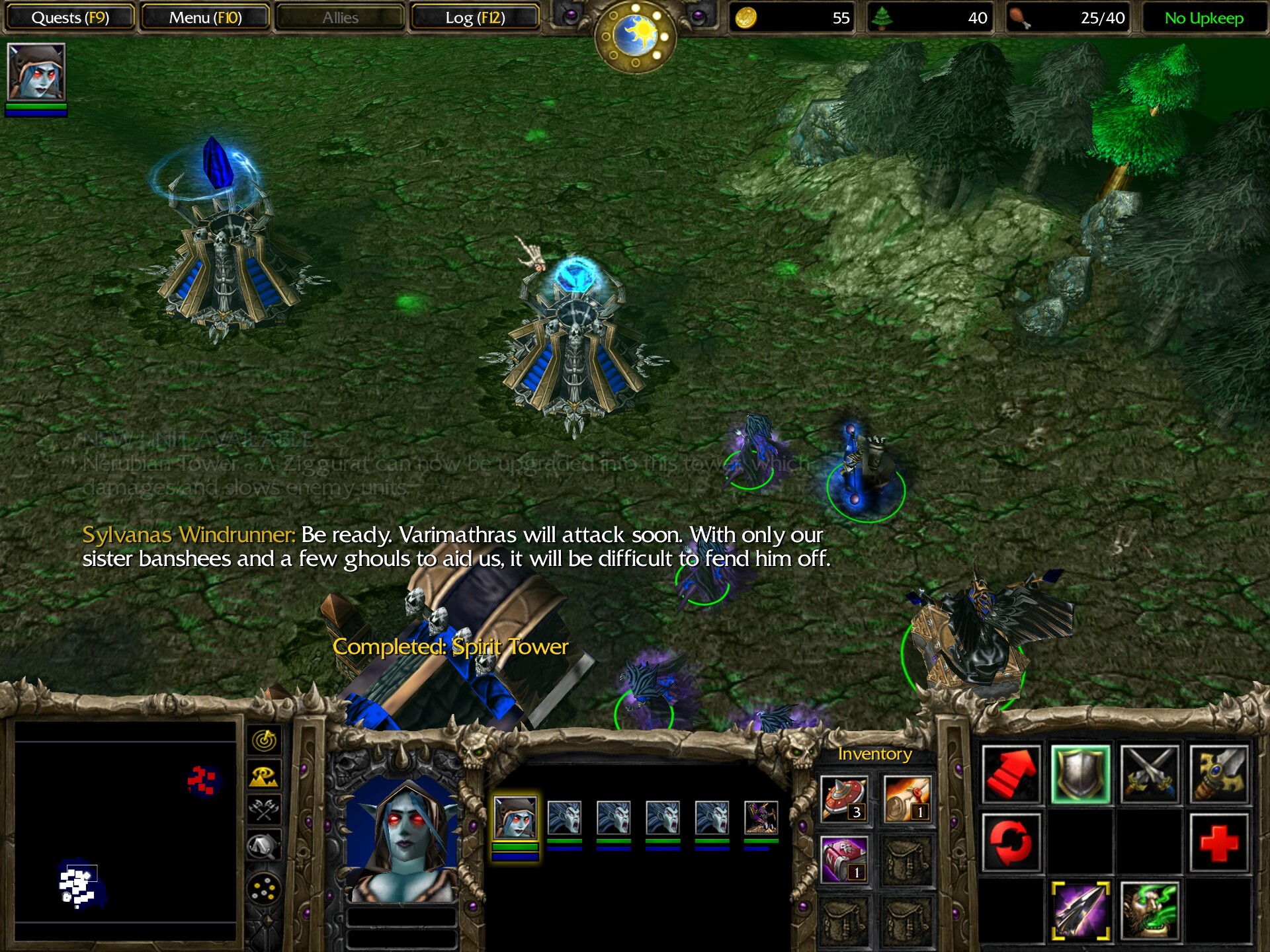
Sylvanas’s base has a very gimped undead tech tree. We can only build ghouls, meat wagons, obsidian statues (a new support unit that restores mana to nearby allies), and banshees. Thankfully, the latter start with Possession already unlocked, and Possession will give us everything else. This entire mission is built around this one mechanic, and in a very satisfying way.
Varimathras’s first attack comes soon in the form of two abominations5, which we steal.
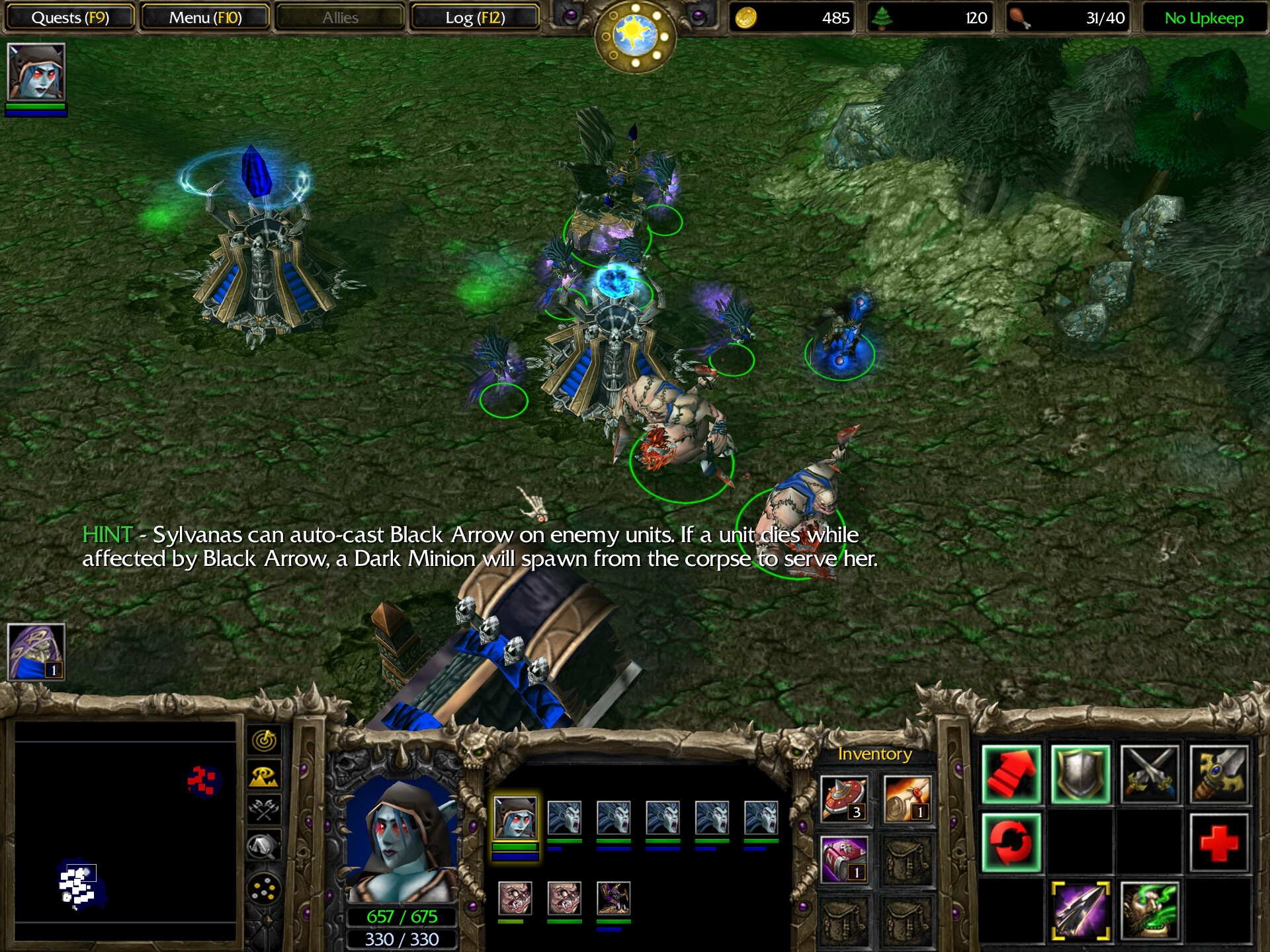
As we start exploring our surroundings, we run into some ogres. We possess them too. Our squad of frontliners is growing.
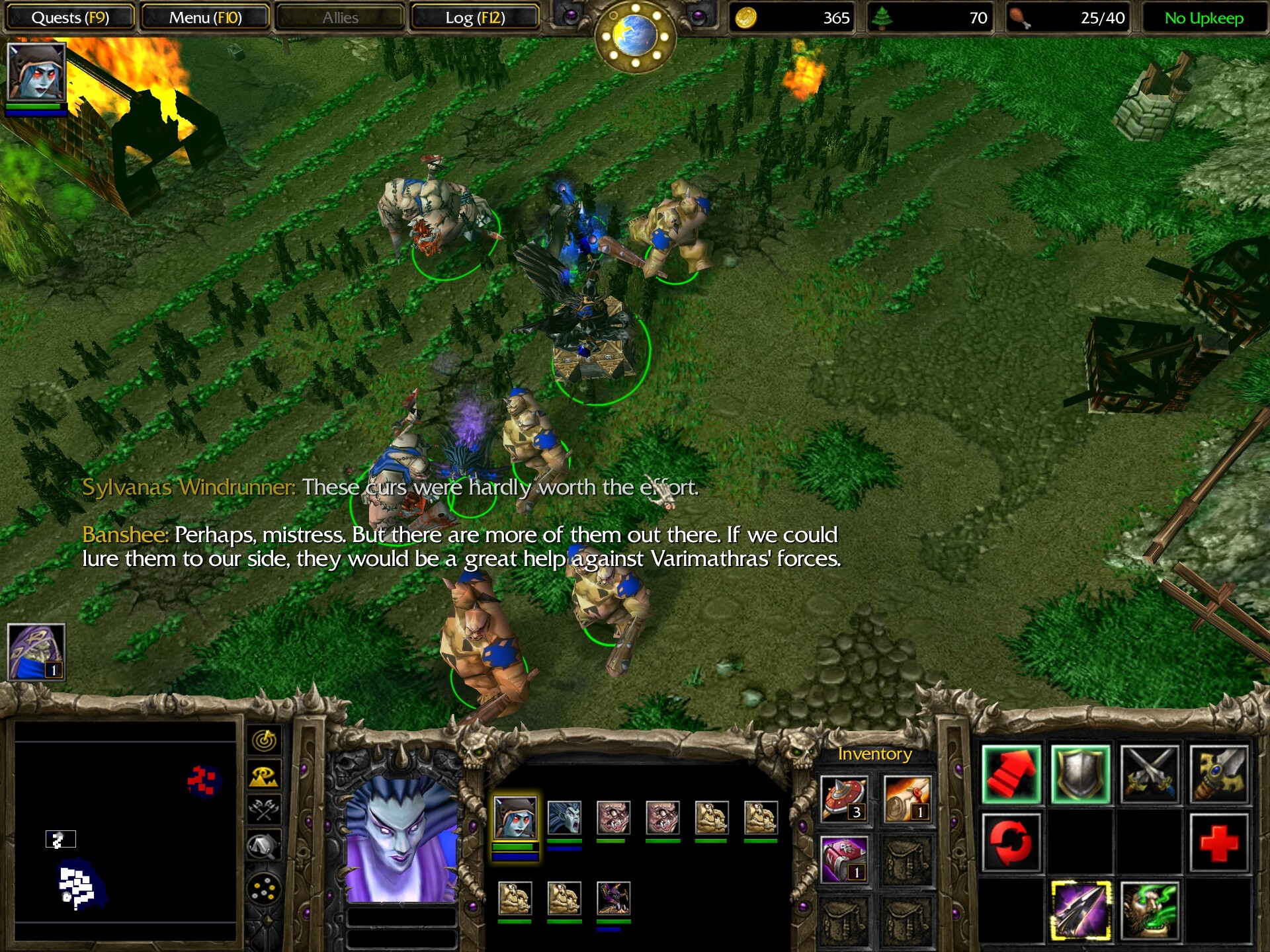
Possessing them reveals a whole ogre camp on the map. Ignoring the ogre minions, we push all the way through without fighting until we reach their leader, and possess him, which causes the entire ogre camp to fall under our control. Best of all, the ogres cost no supply.
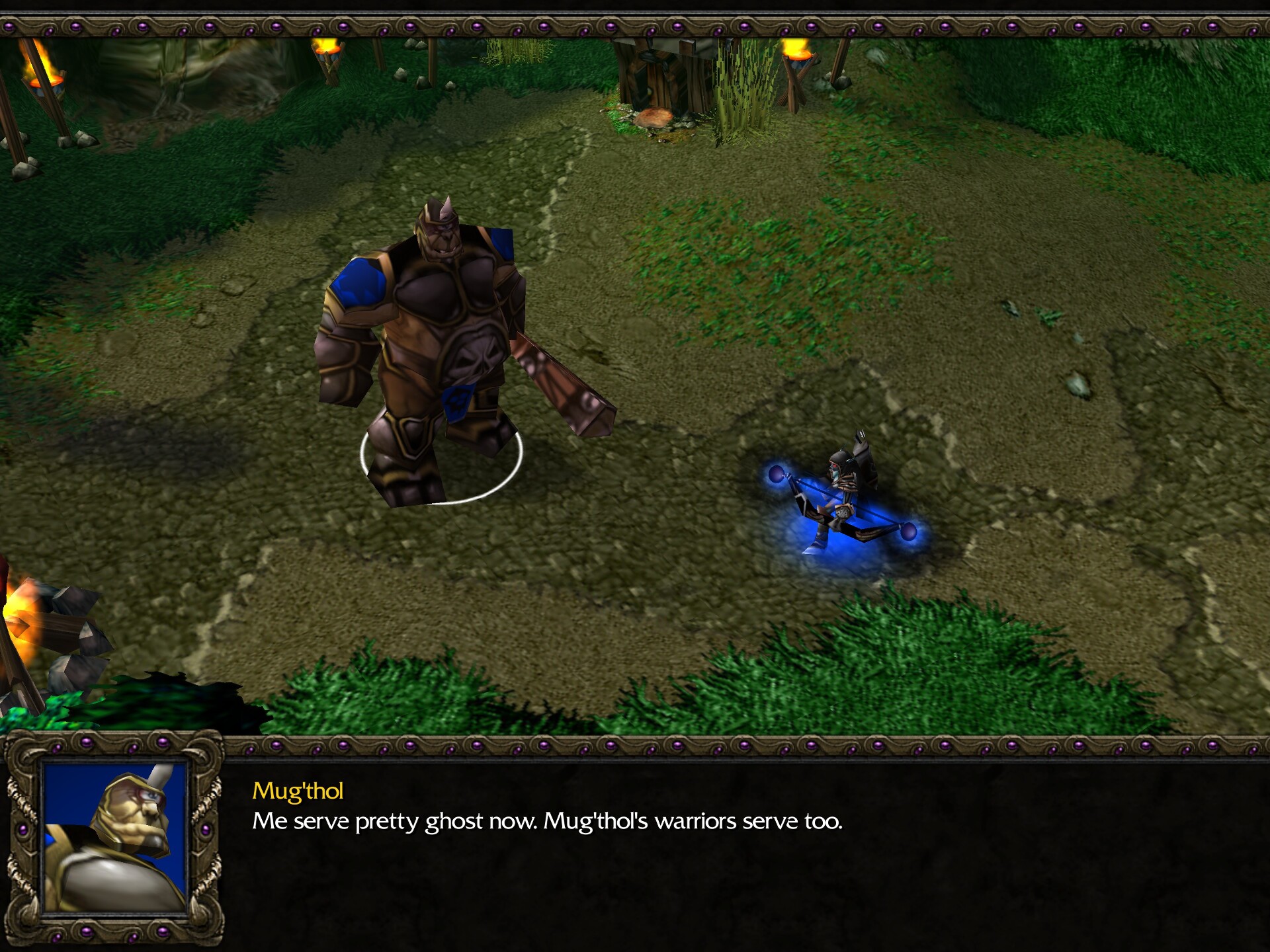
Actually, here’s something I don’t understand. If we’re going to let gameplay mechanics intrude into the story, it might be good to establish how they actually work in-universe. I always interpreted Possession as the banshee’s soul taking over the victim’s body by ejecting the original one, and that’s how it’s described in the manual, so what am I actually looking at here? Is this an elf woman in an ogre’s body doing her best impression of the “lesser race” dialect?
We now have an army of ogres, and the fun’s only starting. Back at the base, I build up towers and keep a few banshees on standby to possess Varimathras’s attacking forces, while Sylvanas marches towards a camp of gnolls.
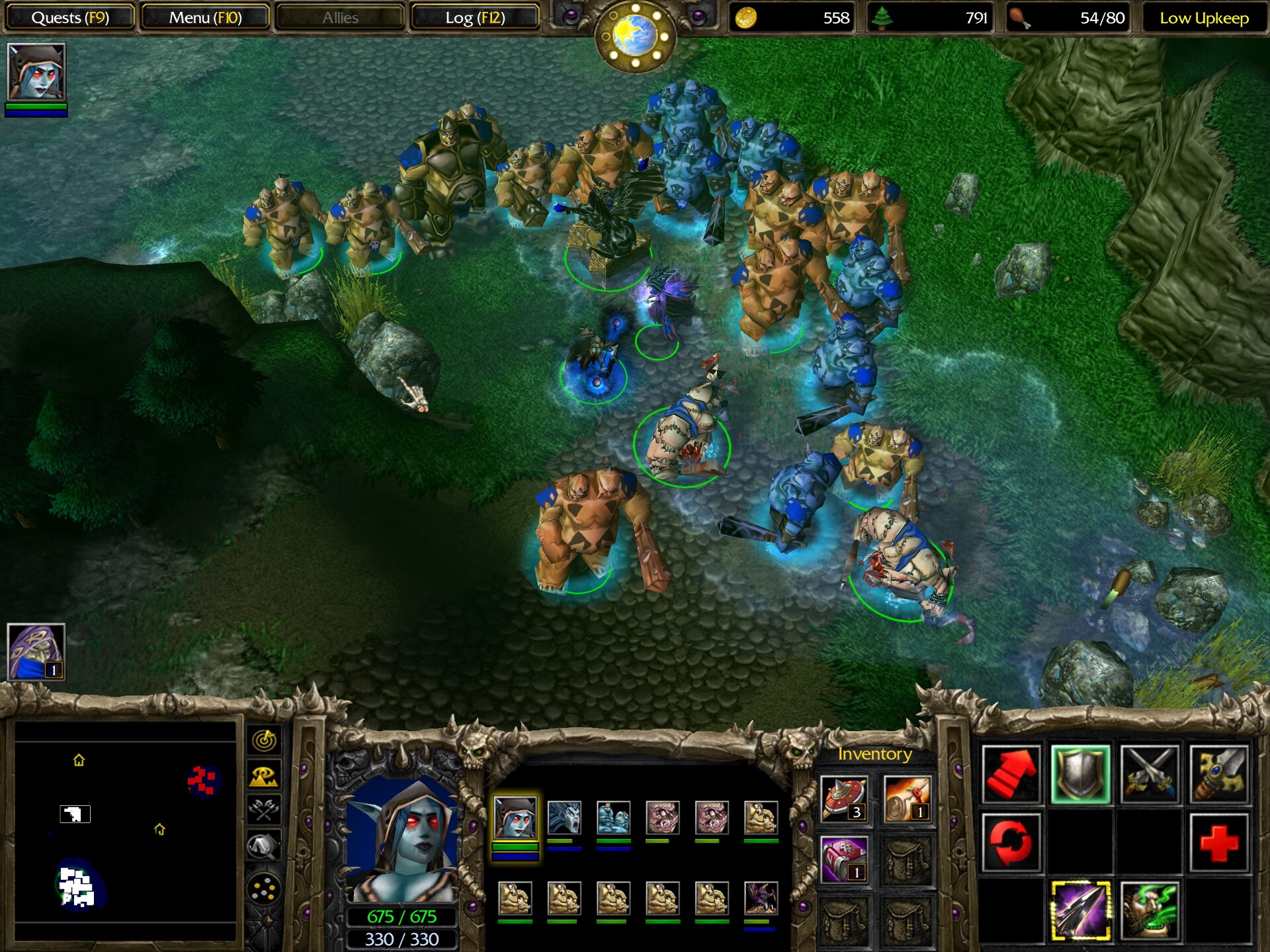
The gnolls take some time to possess individually, but they bolster our forces with an aura and provide some support troops.
Next is a bandit camp. Again, we ignore all the minions and rush straight towards the leader, and once he’s possessed, all his forces flip to our side, too.
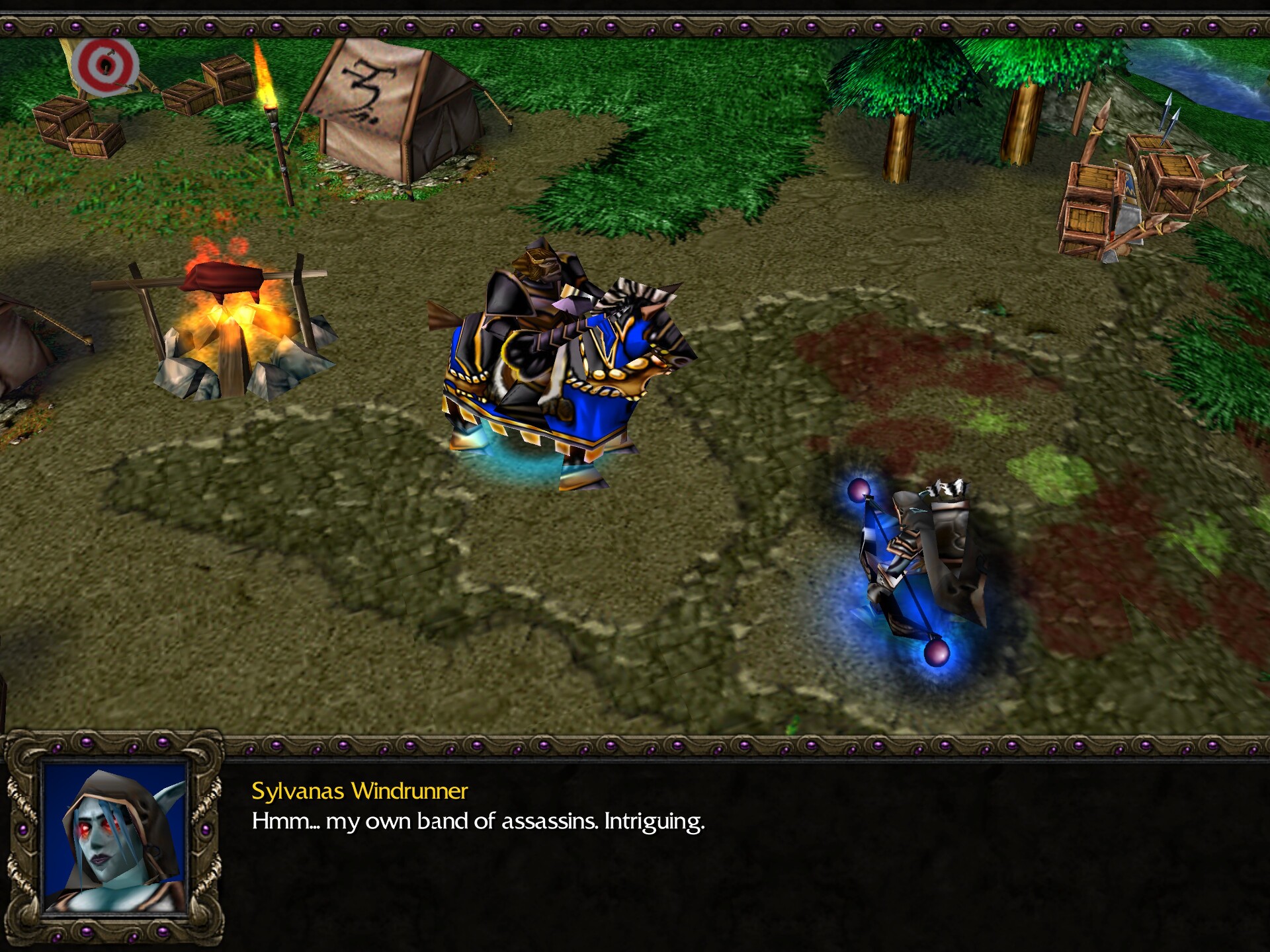
By now, we have amassed a truly ludicrous force consisting of ogres, gnolls, bandits, and Varimathras’s abominations and crypt fiends. Like the ogres, the bandits cost no supply. Cut dialogue lines indicate that there were supposed to be similar “possess the leader” side quests for gnolls, murlocs, and trolls too, which would have left us even more overpowered.
Varimathras’s base doesn’t stand a chance. Whatever defenders it can muster, I simply steal with my remaining banshees.
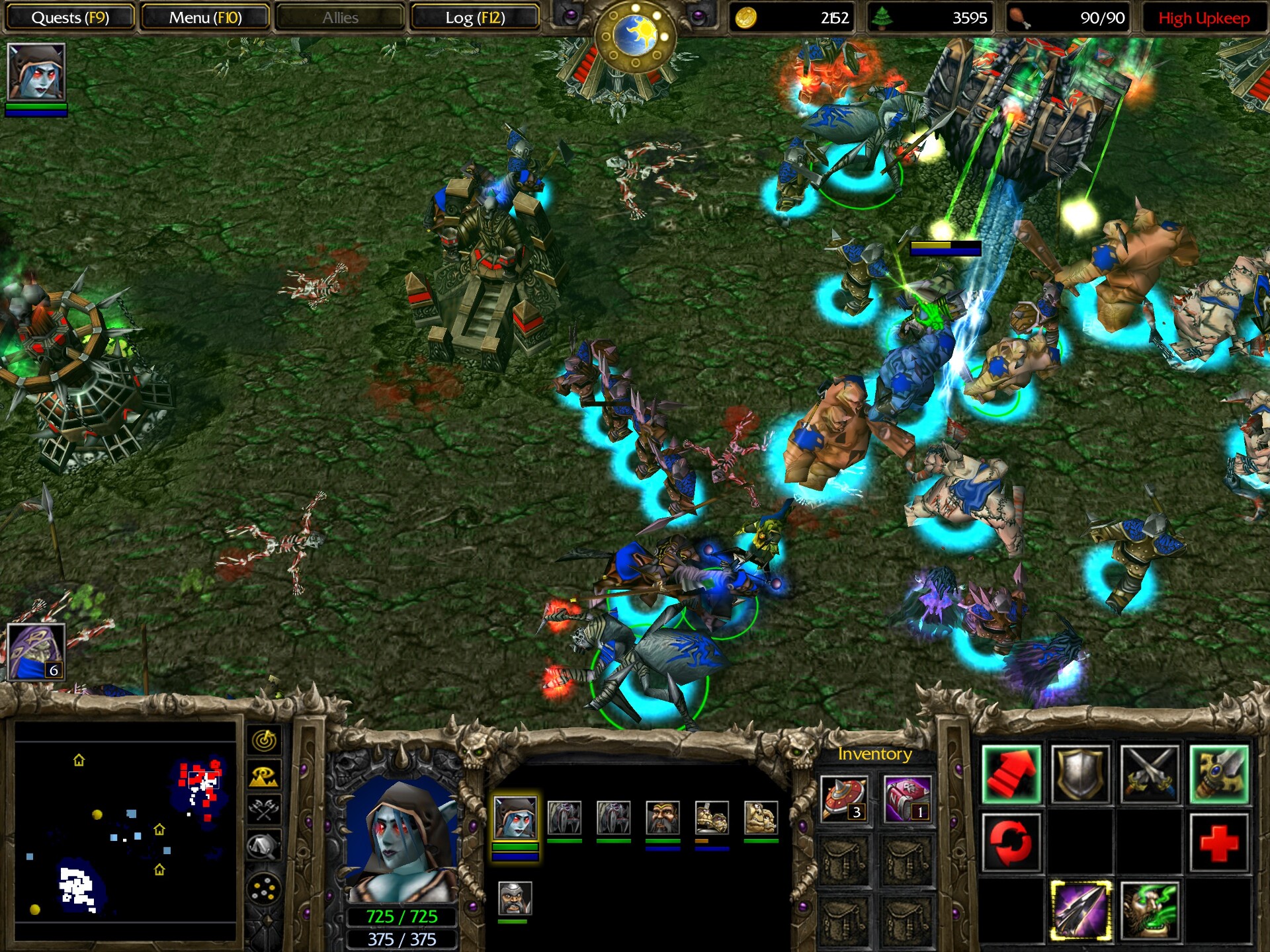
And there we go. Another fairly short and sweet mission, reportedly difficult on hard, but a breeze on normal — built around a single mechanic that lets the player turn pretty much the entire map against the opposition. Like the mission where Arthas relies on mercenaries to sink his ships, it lets us have fun with the many, many types of neutral creatures in Warcraft 3 by putting them under our control — while showing just what a terrifying snowball ability mind control is in-universe.
Once his base falls, the dreadlord begs for his life, pleading that he can be of service to Sylvanas. “Just like a demon,” remarks Sylvanas. “You’d sell your brethren out just to save your own skin. I’m listening.”
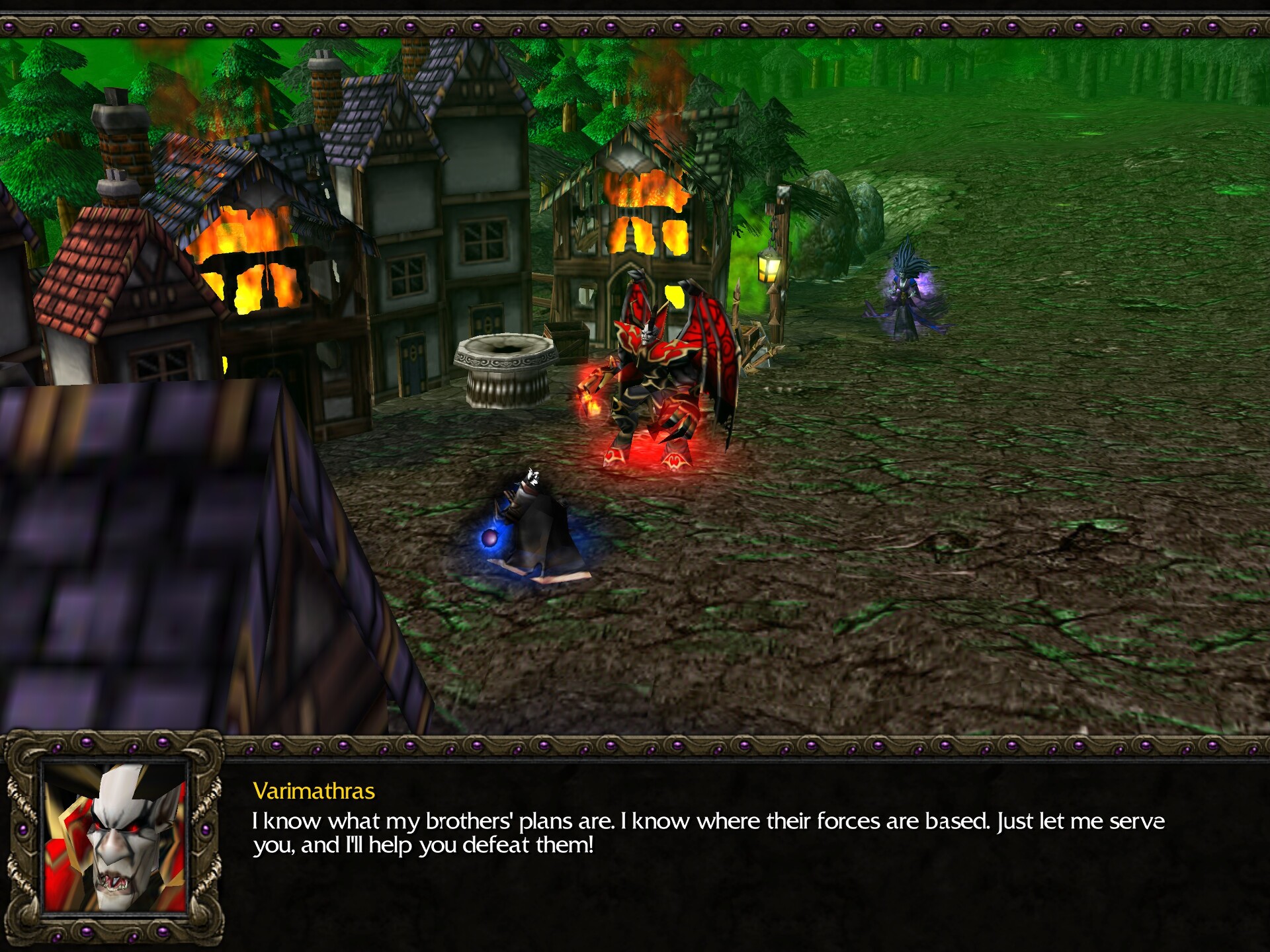
Sylvanas accepts the offer. She’ll let Varimathras prove his loyalty to her — but she’ll be keeping him on a leash.
Next up: Arthas receives a cold welcome in Northrend, and Sylvanas faces the remaining two dreadlords. But where is Kel’Thuzad?
-
The development of World of Warcraft was long underway by the time TFT development started, and its undead faction was there pretty much from the start. ↩
-
As an aside, while he’s a normal dreadlord in classic TFT, Reforged for some reason gave Detheroc a fat model. No, I don’t know why. ↩
-
Incidentally, one of the three paladins is Magroth the Defender, the same one we rescued from naga captivity in the night elf campaign. Continuity! ↩
-
Specifically, they were made from Ner’zhul’s orc followers. ↩
-
On hard, it’s four abominations plus Varimathras himself. ↩
Leave a Comment